PITCHCARE



AND WHY IT’S CAUSING SO MUCH OF AN ISSUE FOR TURF MANAGERS
science spotlight: what is a ce mark? Navigating Turfgrass Diseases save thousands of pounds with a borehole




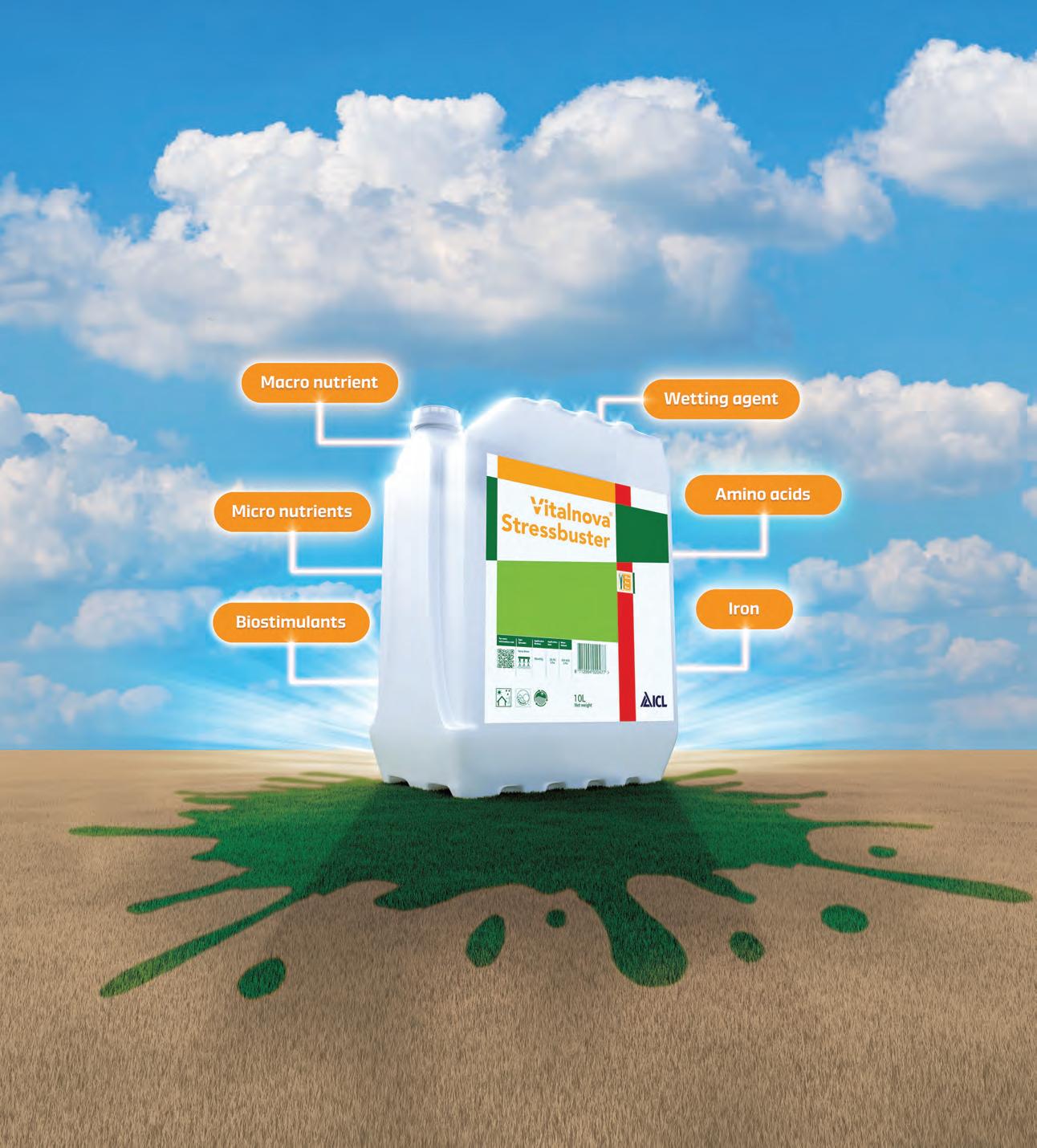






www.icl-growingsolutions.uk | www.icl-growingsolutions.ie Researched, formulated and produced in house by ICL



Editor Kerry Haywood

So, there you have it.... the longest day has been and gone and we are well on the way to darker nights, autumn - even winter for that matter and, of course, Christmas!
A couple of weeks of lovely weather aside, it doesn’t feel as though summer has even arrived yet, but from a turf manager’s perspective at least the rain has let up and allowed renovations and general maintenance to return to ‘normal’if there is such a thing anymore?
There is no doubt that last winter was a shocker, with England enduring the wettest eighteen months since 1836. In our cover story, industry expert Mark Hunt delves into what was behind winter’s weather patterns, crunches some numbers to see why it caused so much of an issue for turfgrass managers, and looks at the reasons behind this (page 8). We know that with wet weather comes an increased risk of turf disease and, in an article on page 36, Dr. Jonathan Knowles (Head of Sports Turf Academy at Leicester City Football Club) offers clear and practical insights on turfgrass diseases.
Also in this issue, our Science Spotlight covers the important topic - ‘What is a CE mark?’. Henry Bechelet, Technical Manager for ICL, tells us why The Fertilising Product Regulations are raising the standards for our industry (page 26).
Our regular features include Top Tips - topdressing advice (page 24), Wellbeing - vandalism heartbreak at Lickey Hills Golf Club (page 62) and a plethora of technical articles including the future of sustainable landscaping - battery v petrol (page 52), technology for groundcare managers (page 70) and an interesting article on how we turn the tide on the recruitment crisis (page 84).
At the time of writing this foreword, England are about to go into their Euros semi-final game (dare I say, it could be coming home). Aside from some tough home nation watches, media focus has been on some of the performances of the German pitches, with divots a common occurrence. Seldom in today’s world do the pundits and tabloids ever have justifiable material to criticise UK pitches, which is testament to the dedication, expertise and skill of our fantastic groundstaff and the thriving turf industry we are part of.
Good luck to the team at Royal Troon hosting The Open and all those who have presided over the grass court season, as the ultimate major tennis spectacle is underway.
Kerry
t: 07973 394037
e: kerry.haywood@pitchcare.com



Allscott Park, Allscott, Telford. Shropshire TF6 5DY t: 01902 440270





No part of this publication may be reproduced without prior permission of the publisher. All rights reserved. Views expressed in this publication are not necessarily those of the publisher. Editorial contributions are published entirely at the editor’s discretion and may be shortened if space is limited. Pitchcare make every effort to ensure the accuracy of the contents but accepts no liability for its consequences. Images are presumed copyright of the author or Pitchcare, unless otherwise stated.
Printed by Buxton Press Advertising TSP Media t: 01952 234000


Mark Hunt delves into what was behind this winter’s weather patterns and crunches numbers to see why it caused so much of an issue for those
Save
Matt Draper - England Golf Governance team Club, County & Membership Director explains.
Aston Villa FC
The past few months saw Villa securing UEFA Champions League qualification and Karl Prescott and his team scoop the Premier League Grounds Team of the Season for 2023/24.


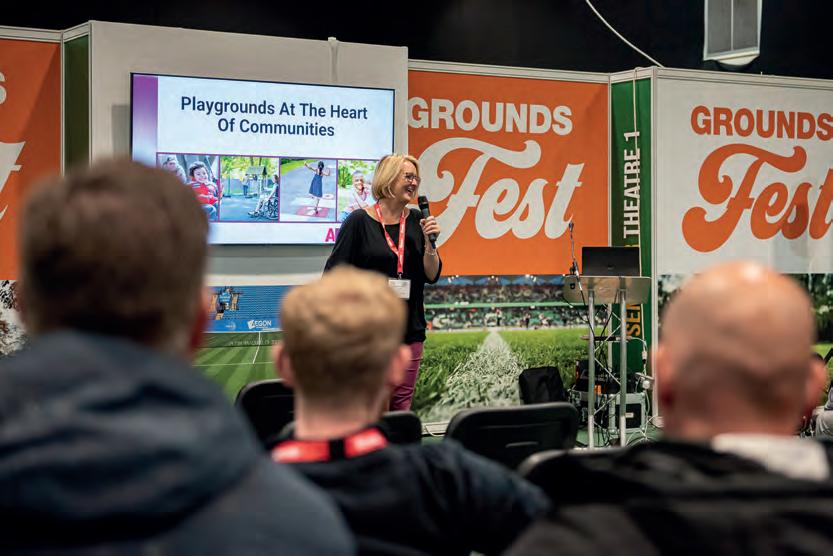
Clear and practical insights, serving as an introductory overview for those new to understanding turfgrass diseases or as a refresher for seasoned professionals.

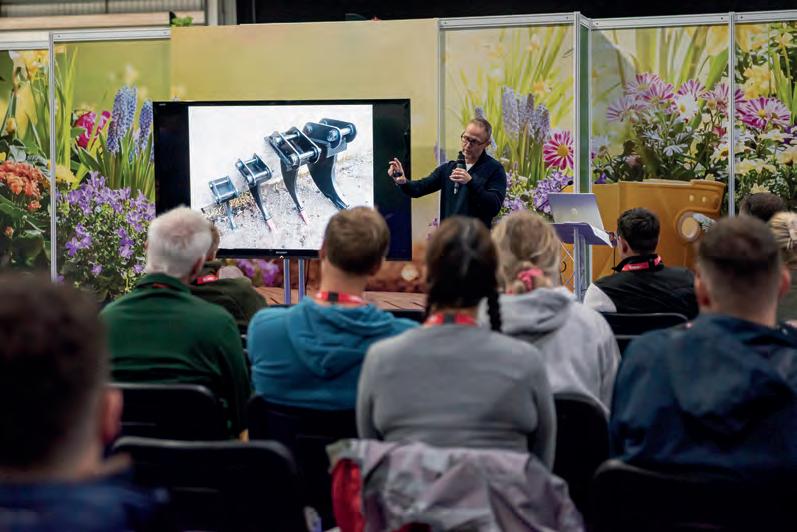









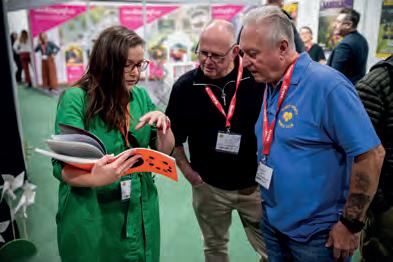



Why you need to a end...
Outdoor Demos




Free Practical Training





Indoor & Outdoor Zones
Landscaping Zone
Retail Area

On-site Camping
Central location




Evening entertainment including a fully licensed on-site bar, Live DJs and bands.





The idea behind the R&A’s Golf It! initiative was to create a space that introduces people to and promotes the game of golf while proactively giving back to the local community through an apprenticeship programme sponsored by The Toro Foundation.
“The R&A’s original idea was to provide a facility where people in inner city Glasgow could play golf,” says Andy Brown, senior manager of global business development and relationships at The Toro Company. “But we realised there was also the opportunity to introduce the concept of greenkeeping as a possible career choice via an apprenticeship scheme, too.”
Developed by the R&A in 2020 to make golf as welcoming and affordable as possible, the facility has grown into a multi-layered experience for all the family with pitch and putt, adventure golf, putting greens and a driving range, and a greenkeeping team was needed to upkeep the venue to the highest of standards.
Andy continues: “Toro was approached to become a founding partner which we agreed to in conjunction with Reesink UK. Toro provides the turfcare machinery and irrigation system required to maintain the playing surfaces at the facility and Reesink provides the support and training via its Livingston branch in Scotland.
“But taking our involvement one step further, we are now sponsoring two apprentices every year for five years. There are currently four apprentices in place and they’re doing very well in their education and getting lots of experience. They’ve had the opportunity to go to America and were on the tournament team for the Arnold Palmer Invitational at Bay Hill in Florida this March.”
Russell Smith, general manager of Golf It!, says: “Community is everything at Golf It! and we’re incredibly proud of our two first recruits Anton Sheilds and Lucy Millar. They see this as the life-changing career opportunity it is and have grabbed hold of it, embraced everything we are trying to achieve and surpassed every goal and expectation.
“It’s has been the same with Toro, they bought into the concept of Golf It! immediately and their support in delivering our goals has been invaluable. We’re thrilled they partnered with us on our apprenticeship scheme, actively funding two roles a year for five years.
To find out more about Golf It! and Reesink and Toro’s involvement visit golf-it.com
Otter Creek director of agronomy Brent Downs has become the 90th Master Greenkeeper since the certification’s inception in 1990.
In doing so, Brent, 43, is just the 36th person to possess both Master Greenkeeper and Certified Golf Course Superintendent classifications, two of the highest accolades available to experienced golf greenkeepers on either side of the Atlantic.
Although a resident of Indiana in the Midwest United States, Brent attributes much of his success to experiences gained during spells in Australia and the United Kingdom. Having interned at Loch Lomond Golf Club in 2007, Brent has become the fourth Master Greenkeeper to be associated with the Argyll & Bute course, following in the footsteps of Ken Siems, David Cole and Janne Lehto. Read the full article on the Pitchcare website.
I’m proud of the part I played in this, but you don’t ever accomplish anything like this on your own.
Brent Downs grateful for the other Master Greenkeepers that mentored, coached and calmed him down
Key findings of the report highlight the role for Integrated Turf Management actions to reduce disease outbreaks, including nutrition, rolling, moisture management and fungicide timings.
Assessing responses from over 100 golf course managers, Syngenta Technical Managers, Glenn Kirby and Sean Loakes, reported the scale of issues with dollar spot have become far more widespread - affecting all areas of the course and for a far extended part of the season.
“Dollar spot had typically been attributed as a summer disease, but the reports have shown it can occur throughout the year, with significant numbers of outbreaks reported from March right through to October,” commented Sean Loakes.

“Furthermore, while it has frequently been associated with less intensively managed tees, fairways and approaches, the report highlighted that greens were actually the most frequently affected surfaces.”
The full Dollar Spot State of the Nation Survey 2024 report is available to download from the Syngenta Turf & Landscape website: syngentaturf.co.uk


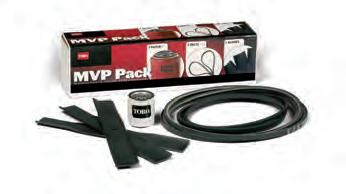
Box clever and save the day by stocking up with Toro® MVP kits. Handy box kits for everything from cutting unit overhauls to lter changes
Toro® MVP kits – all the genuine parts you need in a single package to make ordering and completing the job easier and less expensive.
reesinkturfcare.co.uk
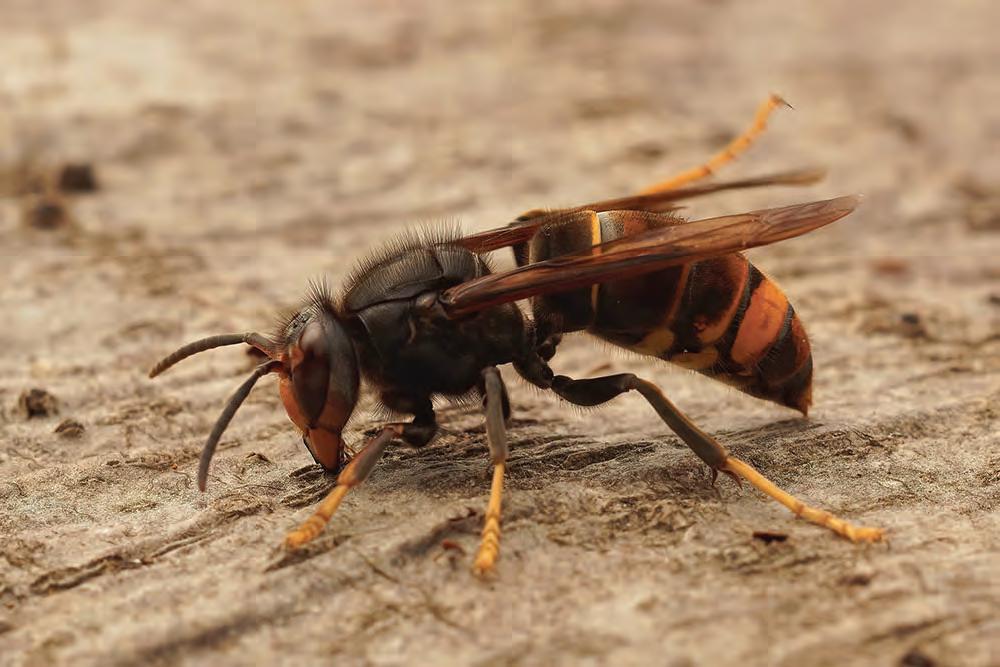
The government is urging the British public to watch out for Asian hornets this summer and to report any sightings immediately.
Although Asian hornets do not pose any greater threat to humans than native wasps and hornets, they pose a danger to honey bees and insect pollinators. A single Asian hornet is said to be capable of tracking down and devouring as many as 50 honeybees in a day.
Asian hornets have not yet made a home in the UK. So setting up traps early is crucial for keeping an eye on these invasive insects and essential for getting rid of them.
What do Asian hornets look like?
Asian hornets are distinct in appearance. They have a dark body, a broad orange stripe on the fourth section of their abdomen and yellow tips on their legs.
What should I do if I see one?
If you come across an Asian Hornet or its nest, make sure to report it right away. It’s important to report any
sightings so that experts can swiftly and effectively deal with the situation and eliminate Asian Hornets.
While Asian hornets typically aren’t hostile towards humans, they may become aggressive if they feel their nest is in danger. Make sure to avoid getting too close to or disrupting a nest.
How can I report them?
If you suspect you have seen an Asian hornet you should report this using the iPhone and Android app ‘Asian Hornet Watch’, by using our online form or e-mail alertnonnative@ceh.ac.uk
Nicola Spence added: “By ensuring we are alerted to possible sightings as early as possible, the public can help us take swift and effective action to stamp out the threat posed by Asian hornets. While the Asian hornet poses no greater risk to human health than other wasps or hornets, they can damage honey bee colonies and harm other pollinators.
Lantra are pleased to announce that Professor John Moverley OBE and Beth Brook have joined the Board of Trustees.
Professor John Moverley OBE is formerly the Chief Executive and Principal of Myerscough College. He joins the Board following his chairing role at the UK Amenity Forum and advisory positions at the Severn & Wye Flood and Costal Committee, and the West Midlands Advisory Committee to the Forestry Commission, where he served as Chair.
Beth Brook is an active advocate for skills development. As the former CEO of the Heart of England Forest, she led the organisation to be one of the first to take on new forestry apprentices, as well as implementing a paid internship in forestry.
GroundsFest 2024 takes place at Stoneleigh Park, Warwickshire on 10th and 11th September and promises an even more impressive lineup of exhibitors, new features and experiences
Don’t miss out on the must-attend event of the year which features: outdoor demos, Machinery Nation Live, free educational seminars, the Landscape Zone, free practical training, retail area, live music festival and much more...
Secure your spot now and join thousands of industry professionals for an unforgettable experience. Visit groundsfest.com











































































more information or a no obligation demonstration call 01332 824777 or visit www.dennisuk.com






























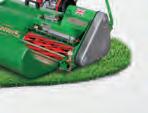





























































































For more information or a no obligation demonstration call 01332 824777 or visit www.sisis.com






















































The word winter apparently comes from the Germanic ‘wintar’ which in turn is derived from the root ‘wed’ meaning ‘wet’ or water’, and so signifies a wet season. An entirely apt description for the winter of 2023/24!
In this article, Mark Hunt delves into what was behind this winter’s weather patterns, crunches some numbers to see why it caused so much of an issue for turfgrass managers and looks at the reasons behind this.
Meteorologically-speaking, winter as a season starts on December 1st and ends at the end of February. Agronomically, I always tend to associate the beginning of November as the start of winter because that’s when we tend to see a marked dip in air and soil temperature. We also see a pronounced dip in DLI (Daily Light Interval) levels in the last week of October as days shorten and nights lengthen! However the media describe it, last winter was a shocker, with England enduring the wettest 18 months since 1836 and many areas of the

Source – U.KStorm Centre,The Met Office (metoffice.gov.uk/weather/warnings-and-advice/uk-storm-centre/index).
U.K receiving >170% of the1991-2020 average rainfall. It isn’t just the rain that has caused an issue, it was also unseasonably warm, with December ’23 and February ’24 in particular posting record monthly air temperatures.
First up, let’s look at some climatic stats from four locations across the U.K, courtesy of the Davis weather station network I work with. I picked Bath, Sevenoaks, Milton Keynes and Manchester.
Before I do, I think it is pertinent to put out that although we very obviously have had a lot of rain, my objective was to try and determine whether there was anything different about this winter’s weather patterns and resulting rainfall.
The first significant difference concerning winter 2023/24 was the sheer number of storm systems the U.K & Ireland experienced. Left is a comparison between the last two autumn/winters.
The storm season runs from the beginning of September to the end of August. You can clearly see that we had eleven named storm systems last winter vs. just four the year before, and two of those occurred in the summer (as I found out to my cost in a campervan during Storm Betty!!).
In the chart above, I have added the ‘nature’ of the storm system including its path and the main area affected in the U.K & Ireland. I also think it is pertinent to point out that we
have had plenty of low pressure systems (and therefore rain) last winter, without them being named as a storm system.
To answer the many questions I had/have about last winter’s weather patterns and their potential cause, I turned to Sebastian Schlögl, head of Meteorology at Meteoblue AG. Meteoblue (meteoblue.com) is the weather company I have worked with since 2009 and I am indebted to Karl Gutbrod, CEO, for his support through my career.
So why so many storms last winter?
To understand the answer to this question, you need to know about the jet stream. We (the U.K & Ireland) lie on the path of the polar jet stream and its ‘behaviour’ is inextricably linked with our weather. When it flows strongly, it is responsible for pushing weather systems across The Atlantic and, when it weakens, it can meander, forming troughs and peaks in which weather systems can get stuck or blocked. To understand this better, go to this link; (metoffice.gov.uk/weather/learn-about/ weather/how-weather-works/high-and-lowpressure/blocks). These blocked weather systems are often associated with extreme weather events, be that rainfall or heatwaves.
Monthly positive anomalies of rain could additionally be caused by many other factors

Here’s Sebastian’s take on my question.
“During an El Niño phenomena, the temperature gradient between the Tropics and the Polar region increases, through which the Jet stream gets stronger. It can bring more low pressure systems, causing a weak decrease in air temperature in the temperate latitudes.”
So, we have a potential link with El Niño, the warming event that takes place in the Pacific and, to boot, something that occurred recently. The majority of storms we experienced were indeed Atlantic storms that followed a traditionally strong jet stream path across the west of Ireland U.K. There were though other Atlantic storms that didn’t follow the normal track/path and occurred when the jet stream flow was weaker. These storms came in across The Bay of Biscay and tended to affect the southeast of Ireland and southern half of the U.K.
The storms that formed further south and tracked in across The Bay of Biscay were the most devasting from a flooding perspective, namely Storms Babet, Ciarán and Henk.
Why was this?
Well, firstly because they were associated with a trough pattern in the jet stream; they were slower moving, meaning we tend to get more

rain and, I believe, more intense rainfall. They also appear to have more energy associated with them and that may be because of a process called ‘Cyclogenesis’ where a storm system intensifies. I wondered if sea temperature had an effect, so I looked at three different locations using the brilliant MyOcean Pro tool on the Copernicus.eu website. Find it here – (https://marine.copernicus.eu/ access-data/ocean-visualisation-tools/ atlantic-ocean-temperature).
At the start of the year, the sea temperature in The Bay of Biscay was 13.369°C, compared to

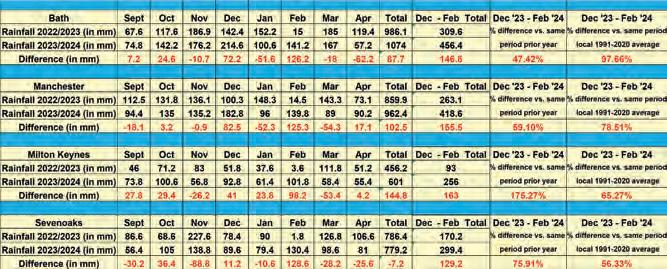
10.589°C off the coast of Cornwall and 11.027°C off the west coast of Ireland. Warmer air holds more water vapour; for every 1°C increase in air temperature, the amount of water vapour the atmosphere can hold increases by 7%. I would theorise that the higher sea temperature and slow-moving track of the storm system allows it to build more energy. (Note - the famous hurricane of 1987 followed the same track into the south of England and underwent Cyclogenesis on the way).
Let us now look (bottom image) at the actual rainfall stats from the four locations I have chosen compared to winter 2022/23 and the 1991-2020 anomaly.
As with any weather statistics, we can see drier and wetter months, but the stand outs were December ’23 and February ’24, which showed significantly more rain than the prior year (remembering of course that February ’23 was one of the driest ever). All locations showed more rainfall than the same period, prior year and the 1991-2020 long term average, with some big differences for the period December to February.
The simple answer is no, because what we saw was more flooding, more saturated rootzones and, as we moved into spring, more growth that we could not keep on top of because you couldn’t get machinery onto the areas to cut. I looked into number of wet days, number of consecutive dry days, but surprisingly there wasn’t a consistent trend, year-on-year.
For sure, we also know that with a wetter summer in 2023, followed by a wet autumn/ winter AND spring, the actual ground water

levels were much higher than the previous winter, so there was less place for water to go in the first place.
The final parameter I looked into was rain rate (in terms of mm per hour) because it is this that causes issues with flooding, bunker wash, etc. If the rain rate is too high, it can overwhelm the infiltration rate of the rootzone it is falling on.
Pictured right are the number of heavy (≥7.5mm per hour) and violent (≥50 mm per hour) rain rate events at the four locations from the beginning of September to the end of February, recorded by a Davis Vantage Pro weather station.
The above analysis clearly shows that in three out of four locations, there were more heavy rainfall events as defined by the rain rate. In two out of the four locations, there were also more violent rainfall events. I don’t think it is any accident that the two locations with the most violent rainfall events, Sevenoaks and
Bath are both close to the point where storms make landfall across the south and southwest of England and, of course, are warmer on average than Milton Keynes and Manchester.
So, my conclusion is that in some locations (Manchester) we just had more rain, plain and simple, but in others, not only did we have more rain, but the rain rate it fell at, and the frequency of heavy/violent rainfall events increased.
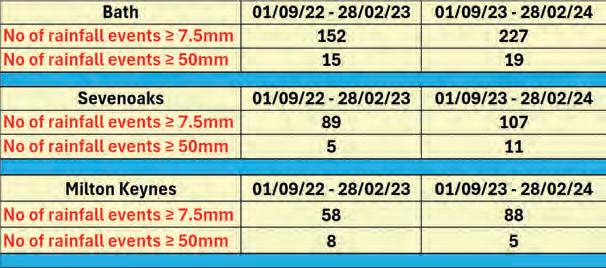


Mark Hunt has worked in plant nutrition and disease management
R&D over the last thirty years. He joined Prodata Weather Systems in 2021 and continues to share his expertise and advice of weather analytics to turfcare professionals. weatherstations.co.uk
One last meteorological question...
I’ll leave that answer to Sebastian Schlögl from Meteoblue…
“Now, there are several connections between the Jet Stream, the weather and the climate change. Recent publications from scientific experts suggest that the Jet Stream will meander more with climate change, because the arctic region becomes warmer, faster. That causes the temperature gradient between the polar region and the equator to decrease, which could further cause the Jet Stream winds to become less strong.
This leads to a stronger meandering of the Jet Stream, so the amplitudes of the Jet Stream waves become stronger. That might lead to a longer persistence of weather situations than usual, occasionally resulting in, for example, long heat waves or continuous rain. But, keep in mind, that even with future predictions of climate change, the monthly positive anomalies of rain you have observed in Britain last winter are very difficult to directly link to long-term Jet Stream shift, because the latter is more a climate-related issue. Monthly positive anomalies of rain in Great Britain could additionally be caused by many other factors which interact with each other in a very complex way.”

Turning to the agronomic consequences of the above, there are many, varied and entirely dependent, as we can see, on which part of the U.K & Ireland your facility is located in.
Intense rainfall events are by their very nature extremely localised, with large differences in rainfall between two sites just a few miles away. Alongside rainfall, we also had a very mild, some would say warm, winter and the continual growth this provided has caused issues with respect to maintenance, but this is a two-sided coin because growth is not only an issue, but an opportunity. Something I hope to discuss in my next article.
To be able to deal with significantly more rainfall events AND more intense rainfall, it comes down to soil type, rootzone characteristics and surface organic matter levels. Surface organic matter is the first consideration and we aren’t just talking
about %’s here. If the nature of the surface organic matter is compacted, with a low level of topdressing through the profile, then it will provide the primary barrier to water movement regardless of the actual % O.M stated on a physical analysis report. After that, we have the ameliorated rootzone (hopefully L2 and L3 in my aeration image above) and finally the drainage layer. This is a complicated topic because obviously there is huge variability in soil type across a facility and the areas that are managed/unmanaged. One area that intrigues me is how rootzones are actually performing from an infiltration rate perspective vs. the actual rainfall intensity we are experiencing nowadays. Finally, we have plant growth regulator timing and usage, disease management and nutrition as the other significant considerations to discuss.















It’s not the weather for a promotion
Peter Smith was recently appointed as head greenkeeper at Bathgate Golf Club, however, due to the challenging weather, his first year in charge has been one he wants to forget.

Peter Smith Head Greenkeeper

Throughout the last ten years, the average rainfall in winter at Bathgate has increased from 502mm to 831mm in 2023 and Peter thinks it will keep increasing…
Due to increased rainfall, Peter has struggled to make and sustain plans to improve the course. “You make plans a day in advance and then it rains twice as much as you expected, so you then have to scrap that plan. More often than not, you won’t be able to do any work because of the ground being saturated and flooded, which massively impacts general maintenance and projects; we’ve had nearly 800mm of rain throughout the last five months!”
The team had planned to do a bunker programme and a green reshape in order to improve the course throughout the winter, but unfortunately these are still incomplete. Peter told us why: “We tried to beat the weather by starting the projects in October, but because of the insistent weather we couldn’t progress anything for a good few months.”
Another factor of the increased rainfall is the closure of the course and Peter has taken a cautious approach: “We have been shut a lot more this year compared to the previous years, as I have tried to protect the course. I wanted it to be ready for the summer and most members were accepting of this at the beginning. That is what we need as greenkeepers, especially when the weather is against us.”
“However, after a couple of months of closing the course, we started to get pressure from
members. Sometimes, it is out of your hands and closing is the best thing to do, but members became more and more impatient. The greens committee were full of support for Peter and his team: “They knew what we were trying to achieve, but there is only so much work you can do in the rain. We have people on the committee who have been members for fifty years and never seen it as wet as this winter.”
Despite the weather challenges, Peter is seeing the positives of his damp first year in charge: “It has been good to be in the worst case scenario and I have definitely learnt the areas where the course struggles with rainfall. I hope next year won’t be as hard as this one, but the weather appears to be getting worse every year. We will rearrange our schedule and try and do work earlier by starting projects at the end of September. This weather is the norm moving forward and those in turf care must plan around it.”
With the weather being challenging, the club have invested into looking after the greens team. Peter concluded: “We purchased waterproof clothing for the staff which has given them more encouragement to get out and do the work, despite the challenging conditions. It can be a long day out in the rain, but the spirit of the team has increased due to the improvement of workwear.”

Climate change is predicted to bring hotter, drier summers accompanied by wetter weather patterns and more frequent, heavier, downpours.
Over the past few years, this prediction has been playing out right across Europe, with more intensive periods of heat and drought alongside more frequent periods of heavy rainfall. The past 12 months have been particularly challenging for anyone maintaining sports and amenity turf, with continually saturated soils making it extremely difficult to present playing surfaces to usual standards.
Consequently, these changing weather patterns have altered the way turf managers are using surfactants. Rather than the focus being solely on improving the effectiveness of applied irrigation and managing drought stressed turf, surfactants are now being used year-round. Aquatrols have developed surfactants proven to improve surface infiltration and reduce run-off during
wetter periods of the year. Chemistries are now available to move water more quickly through saturated soils and improve surface infiltration rates on already wet ground. In autumn and winter, maintaining as dry a turf surface as possible is key - not only for keeping sports surfaces firm and in play, but also to reduce potential for disease and organic matter build-up. Consequently, the use of surfactants now have a role to play in soil water management year-round, enabling turf managers to better cope with these more challenging conditions.

For Aquatrols, we have had to consider how the unpredictable weather patterns impact our operations. One response has been for us to increase warehousing capabilities both in the UK and Europe. This ensures that we have the right surfactants available at the right time for our distributors and their customers - regardless of what the weather brings.




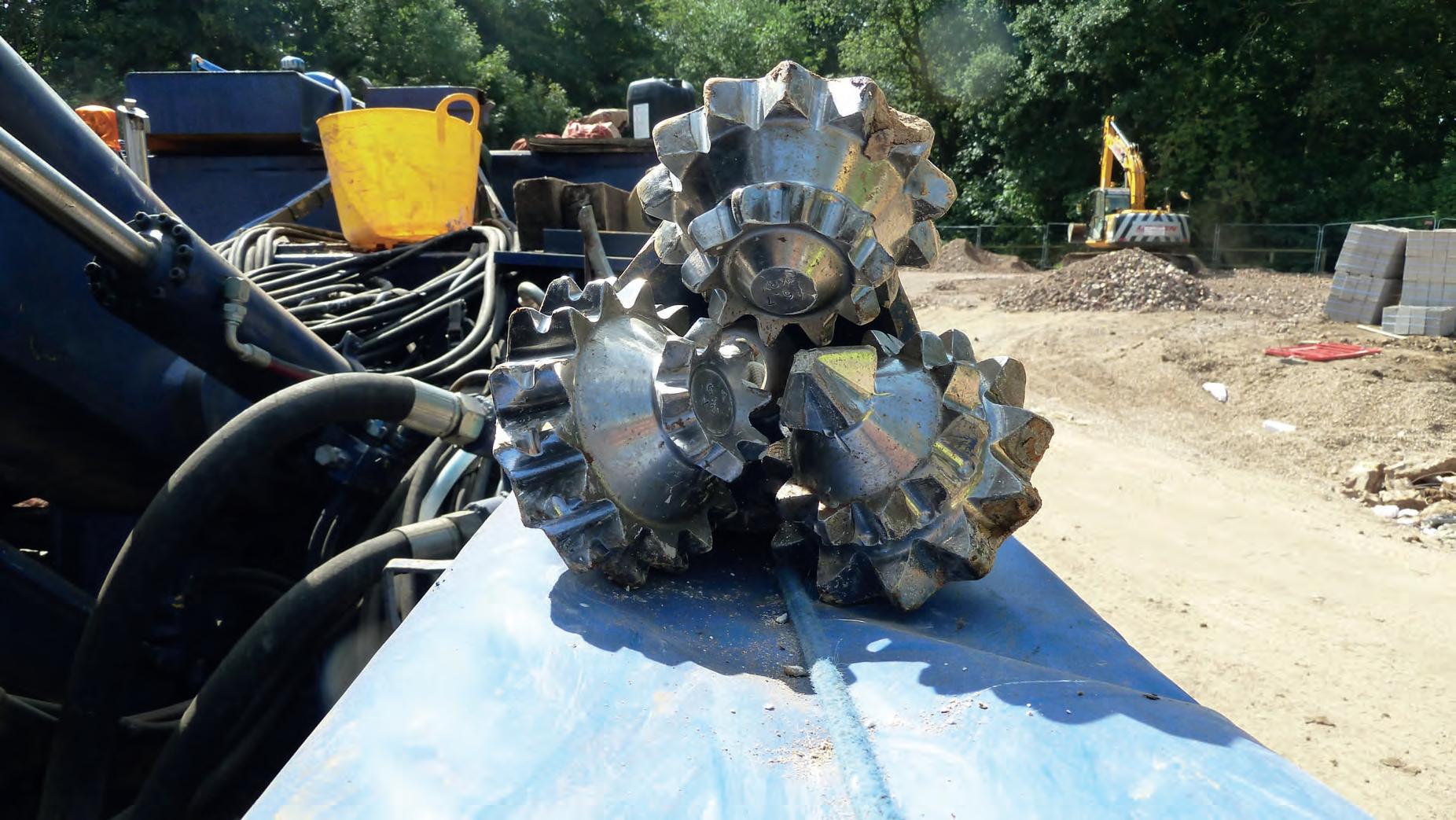

As the prospect looms large of steep rises in water bills, the opportunities look even brighter for clubs to invest in water management measures, such as boreholes, that could save them tens of thousands of pounds and more, annually.
Rainfall may have reached record levels over winter and through spring but recent climatic trends suggest unprecedented heat is also a fact of life now, and when drought descends on us, government bodies such as the Environment Agency (EA) act swiftly.
“The EA knows the locations of boreholes across the country and can impose a ban on
abstracting water from them if the public water supply is under threat,” says groundwork specialist Richard Greenaway, who advises clients on the feasibility of drilling on their land.
Having sunk boreholes and installed supporting plant and equipment for golf clubs across Britain, he believes they present an even more cogent solution now, in the face of steeply rising mains water bills.
“They only make sense financially for



those drawing large quantities, golf clubs for example, and payback times can be as short as two or three years. From then on, the water’s free,’ he says.
The regulatory framework surrounding them is surprisingly straightforward, at least at the lower end of consumption. “Anyone can extract up to 20m3 (20,000l) a day without requiring a licence to bore.”
“More than that and you have to contact the EA for a licence to abstract, but there is no restriction on where you can sink one, except when it will interfere with existing sources. The EA maps borehole sites so knows if there is a danger of that.”
Equivalent to three skip-fulls of water, the threshold for licence-free abstraction sounds plenty enough, but in the wider picture, it isn’t. Some 660 million gallons of water are lost from the mains network every day across the country because of leaking pipes, figures reveal.
Security of supply will be a concern for clubs wishing to avoid interrupted service. Recent contamination of regional potable water
disrupted thousands of homes, and not for the
a day mains draw, your water bill will be around £20,000 a year,” Richard gauges. “Most golf clubs use up to that quantity but some want three times that amount, making investment in a borehole an even more attractive proposition.”
Sinking a borehole to abstract water for irrigation is likely to be looked on kindly by the EA, as it goes back on to the ground, Richard explains, but there’s not an open door everywhere in the country, he adds, “It’s not granting abstraction licences in
England sits on a complex geological substrate. “In the south, predominantly chalk, which absorbs a lot of water. The water quality is exceptional, with lots of lime in it.”
“Most of Cornwall rests on solid rock and
Bottom Completed manhole for borehole installation.
Below Aquifer map of Southern UK.

underground water is few and far between. Great oolite and carillon lie beneath the Cotswolds. South of Birmingham, it’s mudstone and quality can vary. The North is more permeable and water percolates layers faster.”
Below 50m under the surface is ‘a huge swimming pool’ – aquifers holding water that has filtered through layers, sometimes taking centuries to do so, resulting in purity Richard says is so high, it’s drinkable straight from the ground, without any need to add chemicals such as the fluorosilicate acid, aluminium sulphate, calcium hydroxide and sodium silicofluoride which tap water can contain.
“Groundwater is so clean mainly for three reasons,” he explains. “All life needs light, oxygen and warmth. Underground, there’s no light, little oxygen and the temperature is only around 6 degrees C. Water percolates through the ground surface then starts its long, slow journey down to the aquifer.”
First step in a golf club borehole project is to evaluate the ground formations under the course to discover how much water is available to extract. “Some areas on chalk or marl formations can provide hundreds of cubic meters of water a day. Other aquifers, on rock formations, may yield only three or four,” Richards says.
Other factors may prohibit one sometimes. “I access the British Geological Survey’s historical records service to research where they have already been sunk locally. A free report informs clubs of my findings.”
The BGS Water Situation Report reveals the water table level, which rises and falls depending on rainfall. “The average between winter and summer across the country is about 8m.”
Sinking a borehole starts with drilling through the surface into central areas, where the bore penetrates fissures or fractures in the rocky layers. Their number determines how much water floods the bore, which may be anything
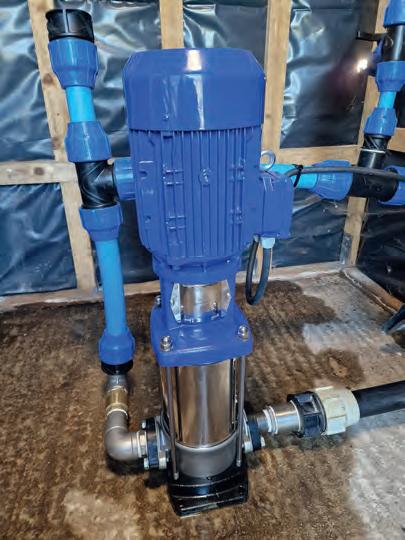
from 5 to 1,000m3 a day.
“Typical depth is 90m and I advise at least a 30m column of water standing in the borehole to future proof supply and allow for seasonal variations in aquifer levels. Pumping equipment with up to 10 bar pressure capacity will lie near the bottom of the bore, which is fitted with a protective stainless steel rising main. Water’s then channelled into tanks then pumps through pipes around the course.”
The cost of installing a borehole – typically a four to six week project - depends on many factors, Richard says, including depth sunk, material drilled, access, pipework runs and trenching.
“Every borehole is different, making it hard to generalise, but payback times average four years, sometimes less. My advice to clubs is always seek out a contractor who can deliver a turnkey project as the knowhow needed to construct a borehole requires the skills of a plumber, electrician, groundwater specialist and pumping engineer.”
Article by Greg Rhodes.







Aquatrols o ers a full range of proven water management products for every turf management need and budget. Continuing your surfactant programme year-round can signi cantly improve turf and soil health, optimising your playing surfaces, whatever the weather throws at them. E ective water management plays a huge role in getting your water and other applied products through the soil pro le, ensuring consistency and uniformity. After all, prevention is better than cure.


The problem for greenkeepers is that as expectations rise, despite financial and economic pressures, the role of the golf course management team has an almost impossible task to deliver.
To help clubs in this highly charged situation, England Golf have put together a governance team to support club management establish a structure to cope with this increased pressure. Matt Draper - England Golf Governance team Club, County & Membership Director explains, “One of my roles is to visit club officials to help support them establish or enhance their governance framework, which will ultimately
provide greater flexibility for management communication, course improvements and help cascade standards which improve the sustainability of their club.”
For our readers especially, sadly, greenkeepers are often the unsung heroes of the golf industry. They start work early in the morning, must deal with a vast array of challenges (don’t even start me on the weather), and are usually out of the way long before any golfer tees up!



Volunteers can play a critical role in the success of any organisation, particularly non-profit and community-based entities. Their importance stems from their selflessness and dedication to support a cause without seeking compensation. In addition to providing essential services, volunteers contribute to an organisation’s sustainability and can foster community involvement.








Matt explained, “Volunteers not only alleviate pressure on core staff, but they also diversify the talent pool, bringing fresh perspectives and ideas. Their presence can enhance the functionality and effectiveness, and vastly improve the club’s ability to achieve its mission and deliver impactful results.”
Before we all rush out and ‘hire’ an army of volunteers, Matt was quick to balance the discussion....





















































































Before taking on any volunteer(s), there are some key points to consider...
1. Will they need inductions and task-specific training?
2. What workspace will the volunteer need? It’s important to minimise disruption on paid staff.
3. In the absence of pay/benefits, consider the need to make them feel recognised, involved and appreciated.
4. Their need to work flexibly. Think about the needs of paid staff too and whether you can adopt across-the-board flexibility.
5. As an employer, you have a similar duty of care on health and safety issues to volunteers as existing employees.
6. Volunteers will need managing by a team member. Co-ordinating volunteers will help avoid friction between volunteers and paid workers.
England Golf is responsible for the general promotion and administration of amateur golf within England. It organises championships for all age groups and has inherited premier events from the male and female unions, including the English Amateur Championship and the English Open Amateur Stroke Play Championship.
It also administers the handicapping system for golf in England and works to increase the interest and participation in golf among adults and juniors, driven by the Respect in Golf movement that aims to highlight that golf is a sport where everyone is welcome.
There can be no doubt that a working party of volunteers, if managed correctly, can enhance the workforce output and help ‘get things done’! “The objective needs to be focused on what jobs a volunteer can do to assist the greens team.” explained Matt. “It’s important that the key ‘specialist’ agronomic management of the course stays with the trained greenkeepers, but volunteers can support with the simple tasks that green staff don’t always get the time to fulfil.” Matt continued, “Jobs like edging paths, divoting tees, weeding beds, picking up leaves, the list can be endless. It’s the small detail jobs that are so important that will help tidy the golf course and raise its level of presentation.”
Leading the way through communication
“I think it’s essential that in any club structure the course manager should play a leading role in the development of a vision document,” enlightened Matt. “Most club ‘officials’ are volunteers (practical or management), and so the ability of the course manager to guide and bring together all groups and individuals within the club in a common goal will ensure the success of creating a roadmap for the future.”
Matt’s journey
Matt is responsible for club, county, and member relationships, heading up the national club and county support network since January 2021.
Matt joined England Golf in September 2019 as a regional manager, having previously been General Manager at Tadmarton Heath Golf Club in Oxfordshire. He has a passion for golf having started at the age of four and currently holds a handicap of three. His golfing highlight was representing Bournemouth University in national finals and breaking the world record as the youngest person to get a hole in one aged five!
As you can imagine, Matt is a very busy chap supporting so many golfers and clubs up and down the country, so my special thanks to Matt for his time!
To get in touch with the governance team, email- compliance@englandgolf.org
Article by Phil Helmn.















1. Increase firmness in the greens
Greens can get a build-up of something known as organic matter. This is the organic fraction of the soil where decomposition occurs; mainly of plant tissue and other living organisms and, over time, this can cause a spongy surface.
Golfers may enjoy a soft surface, but this can be very detrimental to the green’s health. Utilising the practice of topdressing will lead to much firmer greens, however, you need to find the correct balance as you don’t want them too firm. Reducing organic matter in the greens will be much more beneficial to all-year-round playability.
2. Improve ball roll
James Matthewman is Deputy Head Greenkeeper at Maesteg Golf Club and welcomes
topics for future Top Tips.
In any sport you want the best playing conditions possible and, when it comes to a golf green, the main thing golfers will talk about is how they roll. Regular topdressing fills any voids that are in the turf canopy and creates a perfectly smooth top surface - aiding in a true ball roll. Also, if any renovation work has been undertaken, such as coring or spiking, topdressing will again aid recovery and help maintain that true surface.
3. Changing the soils physical properties
Sand, silt and clay are the three particles that make up soil. The relative percentage of these particles is what will give you the overall texture of the soil. Over time, fine turf can deteriorate if it has not been maintained to a high enough standard. Granted, there can be issues along the way, but nonetheless fine turf needs constant attention.
When you are building a house, if your foundations are wrong, you are going to have many complications, and it’s the same when it comes to your soil profile. Multiple years of regular topdressing will certainly improve that rootzone and changing the soils physical

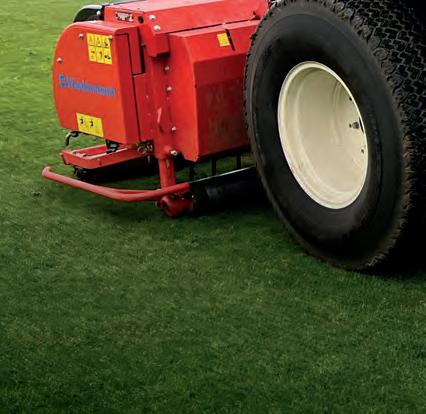










Henry Bechelet, Technical Manager for ICL, tells us why The Fertilising Product Regulations are raising the standards for our industry.
Fertilisers are regulated to ensure that they are used responsibly. The EU Fertilising Product Regulation (FPR) sets the rules for fertilising products sold in the EU.
AFPR compliant fertilisers will display a CE mark which shows that the manufacturer has checked that the product meets EU safety, health or environmental requirements. CE stands for “Conformité Européenne” (the French for European conformity) and the mark is an indicator of a product’s compliance with EU legislation. The Fertilising Product Regulations
are a significant step forward for our industry because they set a higher standard than the previous regulations and encompass a wider range of product types. It is thought that the UK will broadly adopt these regulations with some minor adaptations.
More than fertilisers
FPR defines ‘fertilising product’ as any substance or material used on plants (or rootzone) for providing nutrients or improving nutrition efficiency. The regulations group materials into different ‘product function’ categories such as fertilisers and fertilising

product blends but also things like liming materials, soil improvers, growing medium, inhibitors and plant biostimulants.
Because the new regulations now encompass a broader range of product categories than just fertilisers, we are seeing a greater requirement for products to be registered. Soil improvers and plant biostimulants will need to be compliant to the new regulatory standards if they are to be sold across the EU. This is why we are seeing surfactants being registered under FPR.
Different categories
FPR categorises ‘soil improver’ as a product whose function is to maintain, improve or protect the soils physical or chemical properties, the soil structure or the biological activity of the soil to which it is added. This is a broad product category, but as an example it might include soil amendments to improve nutrient retention or maybe surfactants to improve the water holding capabilities of the soil.
A ‘Plant biostimulant’ is described under FPR as a product whose function is to stimulate plant nutrition processes independently of the product’s nutrient content, with the aim of improving the characteristics of the plant or the plant rhizosphere. This might be improved
If a surfactant bears a CE mark, you need to check what product function category it is being registered under
nutrient use efficiency, a greater tolerance to abiotic stress, improved turf quality traits, or an increased availability of confined nutrients in the soil or rhizosphere. So, this product category is related to plant health benefits rather than improving the properties of the soil. Biostimulants could encompass a broad range of different technologies, but again, surfactants might be included in this category too.
In order to become fully registered and bear the CE mark, the product manufacturer must fulfil the regulatory requirements that relate specifically to the chosen product function category. It is important to understand that different product function categories have different conformity requirements.
FPR compliant soil improvers require a dossier of technical documentation evidencing compliance in multiple areas. Information is required on raw materials, manufacturing process, product use and application information, labels, calculations of nutrient contents, reports on contaminants and list of standards used for testing etc. For soil improvers, there is no requirement for trial data to evidence the product performance.
FPR compliant biostimulants, however, require all the above production and labelling information, but they also need trial results that evidence each biostimulant claim. Multiple trials
must be conducted and reported according to the strict standards set by this section of the regulation. All claims made about the biostimulant must be stated on the label and the claimed effects must be demonstrated during the trial procedure. Registered biostimulants, therefore, require a far greater level of supporting information and evidence of performance to achieve a CE mark than soil improvers.
So not all CE marks are the same
The upshot is that not all CE marks are the same. Depending on the chosen product category, the regulatory demands might differ significantly. Products categorised as biostimulants will need a far greater level of supporting dossier than soil improvers. This is an important detail.
ICL have successfully registered H2Pro Trismart as a non-microbial plant biostumulant under the FPR regulations, and so it proudly bears the CE mark for that product function category. In multiple independent trials, we have successfully demonstrated increased abiotic drought stress tolerance and improved turf quality traits (density, uniformity and colour) when compared against untreated irrigated and unirrigated controls.

Author profile

The H2Pro TriSmart CE mark biostimulant designation builds upon all the other benefits that we have previously demonstrated in numerous other trials (increased nutrient uptake, drought stress reduction, prevention of localised dry spot and significant reduction in water requirements). H2Pro TriSmart is a fully accredited and powerful water management technology that performs well in a number of important areas.
So, if a surfactant bears a CE mark, you need to check what product function category it is being registered under. If the manufacturer has chosen to categorise it as a soil improver, then the CE mark only relates to the production and declaration conformity of the product and it is not necessarily an indication of its performance. If it has a CE mark for biostimulant, then it has been proven to perform in the ways described on the product label. As always, it’s best to check everything… starting with the product label.
Henry Bechelet is Technical Sales Manager in the UK & Ireland for the turf and landscape business. Henry has been in the turf industry for over 25 years. He originally trained as an agricultural agronomist but then joined the turfgrass industry as a trainee agronomist in the early 90’s. Henry has spent roughly half his career engaged in independent consultancy and the other half on the commercial side of the industry. Over the years, Henry has built a reputation as being an enthusiastic and entertaining presenter who has always been very progressive in his views.








The Kress RTKn robot mowers revolutionise pitch maintenance by covering larger areas with precision. Operating autonomously in parallel lines, they efficiently move from area to another. Their sleek design and no need for on-site aerials ensures the aesthetics of the pitch is preserved, and with zero emissions, Kress mowers are the best choice for sustainable turf care.


Speak to your local grounds maintenance machinery dealer today to learn more.





The past few months saw Villa securing UEFA Champions League qualification and Karl Prescott and his team scoop the Premier League Grounds Team of the Season for 2023/24. Kerry Haywood finds out more…
When you’re an avid Wolves supporter, it feels somewhat strange to visit a rival ground, however Head Grounds Manager Karl Prescott immediately made me feel at home when I arrived at Villa Park. It was obvious through the impressive, glazed
boxes that renovations were well underway and we sat down with a coffee where Karl told me: “Even though we are in the middle of renovations, where we will also play host to a Foo Fighters concert, I enjoy this break in the season. We have really good contractors who know what they are doing and that all takes the stress off. If it rains this afternoon, I don’t have

to worry, whereas usually I’m always thinking of feeding programmes, granular liquids in between games and trying to be 3-4 weeks ahead of yourself – which can be stressful.”
Getting the foundations correct are key to a good season and the current renovations are going to plan. Karl continued: “A full Hunter sprinkler system has been added to the pitch edge, and currently Hewitt Sportsturf have scratched the surface of the pitch and will ensure all the levels are correct, and there are no black layers, before applying 90 tonnes of topdressing and add 90/10 mix to a few areas.”

Having said that, Karl is realistic about the demands on new recruits: “That beautiful striped pitch doesn’t just happen and sometimes 14–16 hour shifts are required.
Understanding the science behind what we do to produce a top-quality surface is not only an advantage, but also helps a person’s development and provides opportunities and, as an industry, we have to shout about the positives. I understand the difficulty in that though as I don’t like to brag on social media; I just let the pitch do the talking!”
The award process
“It feels like it’s been a long season with a packed schedule and recruitment issues, but when I speak to other industry people, I don’t think we are alone… everyone is struggling to find skilled staff. I don’t need somebody to come here and produce a day-to-day planner, I just need someone who is willing to work hard and apply themselves to the job.”
“We have received so many positive comments this season about the pitch and its performance and that is the only gratitude I need. Winning the award was the icing on the cake, and the process involved also gives us valuable knowledge and scores throughout the season.”
TEAM OF THE SEASON
The pitch was commended for its exceptional quality throughout the season, despite a high number of women’s and European fixtures as well as the 19 Premier League matches. In addition, the grounds team scored highly for innovation and sustainability, having reduced their use of fungicides and adapted machinery to perform bespoke tasks.

The Grounds Team of the Season Award is determined by a number of factors, including amount of usage, environmental conditions, assessment of resources and management, marks given by the referees and match delegates at each fixture. All these marks go into a pot and the top five are picked out.
Karl continued: “At the end of April, a representative from STRI conducts a pitchquality inspection and we go through every aspect of maintenance and structure; how many staff we have, how many games we’ve played including training sessions, feeding programmes/NPK input, how many fungicides have been used, machinery used etc. All the scores are added together for consideration before they decide the winning team. The award means a great deal to all of us and, going into next season, it offers interesting and exciting times ahead.”
“Being part of the Champions League (the

first time since 1983) will bring more camera crews as well as prestigious clubs such as Real Madrid, which is exciting. Investment in the club is massive which includes stadium development, training ground upgrades, new office space etc. I try not to remember it, but coming from relegations back in 2015 to where we are now is phenomenal. We’ve had two really good seasons which have taken the club to the next level and we need to ride the crest of the wave to see how long we can stay there.”
The foundations are in place to achieve just that as the current surface was a full reconstruction back in 2018. Everything came out and new undersoil heating pipes, irrigation and surrounds were added. Karl commented: “Although I had done many renovations across my career, that was my first involvement in pitch reconstruction. We had about six weeks to grow the pitch in again, but it was an unknown period and an eye opener. We had to figure out feeding programmes again because you’re back to basics and trying to build up soil biology and everything else. You know what worked on the old pitch, but that doesn’t mean it will work on the new one and fertiliser inputs can completely change.”
“Even with the old pitch I tried quite a few different products to find out what actually worked… everything looks good on the tin, doesn’t it! But I was trying to find out, you know, the sort of playing response to different seaweeds and things like that. I really enjoyed that, right down to exploring how much magnesium or calcium is in a product as well as the trace elements, which can make a huge difference. Each environment and soil profile is different; we have West Bromwich Albion and Birmingham City up the road, but they can react totally different to what we have here.”


“I would go as far to say that last season was the best pitch we have ever produced, and everything just seemed to click – so I’m hoping we can continue that success. It’s hard to attribute it to one thing, but the Primo programme supplied by Agrovista Amenity rep Mark Allen worked a treat and we stuck with that throughout the whole season.”
“In my opinion. another key factor was the SGL UV machine. I think that’s a big part of our armoury and helped massively in lowering the
use of fungicides (two were used throughout last season), and the NPK input has also reduced drastically. From growing in, as soon as we see growth, the machine is out. This was our second season using the new lighting rigs and we have a much better understanding of how they work to get the most benefit and not overcooking the surface.”
Machinery investments
Over the past four/five years, there has been a

























Below
Dave
Keith
Karl
Ian
Matt
and Eddie Mills.
lot of investment in battery operated machines for the club and Karl commented: “The club have really helped to upgrade the grounds department machinery so, as well as our trusty Dennis Premier’s, we now have 4 x Dennis ES-860s with various attachments, Allett electric rotaries, 6 x LED440 SGL rigs, 6 x LED120 and a couple of smaller BU10s.”
“We used to use petrol mowers, however, pressure from camera crews to reduce noise for after match interviews has increased dramatically. Without the use of electric machines, my team wouldn’t be able to start until much later – making an already long day even longer. The transition to electric has been another great thing for the environment and

Karl explains: “I came straight out of school and started at Lilleshall National Sports Centre where I completed all my college courses before moving to a local school in Telford. I was there about 12-14 months, but I found the environment difficult. It’s something I wanted to try, and I learned most things at the school because of all the different aspects of sport such as rugby, cricket, tennis etc. and numerous techniques across that time.
It was a good introduction, before the opportunity arose here in 2001 to join the team at the training ground. At that time, there were only three of us and we had 3 full size pitches and 1 astroturf. Now, there are 9 grass pitches and 3 synthetics with a team of 10, and the facilities are improving and growing all the time. In 2008, an opportunity to move to the stadium under Johnathan Calderwood was something I jumped at, before taking on the Head position in 2016… and I’ve not looked back since – because I haven’t had time,” he jokes.
Looking after the stadium with Karl is Assistant Head Groundsperson Ian Hipkiss and Groundsperson Matt Jones. Karl is hoping to employ another full-time person before the start of the season, and also has a ‘good as gold’ team of match day staff (Keith Smith, Dave Collins, Eddie Mills, Harry Rooke and Dylan Stokes). “The match day team are willing to help day or night whenever they are needed,” states Karl. “They all have a passion for the club, but also a desire for the industry which translates into their work and helps greatly with things like clearing the pitch, cutting, moving lighting rigs etc).” It shocked me to hear that it takes approximately six hours to bring all the lights in from where they stored at the back of the club shop, which is the only access point.
I’m sure with the dedication of the team, along with the stadium developments and investment, it wouldn’t surprise me if the awards continue to roll in next season!

















Education & Training | Technical Services
Trials & Research | Tournament Support














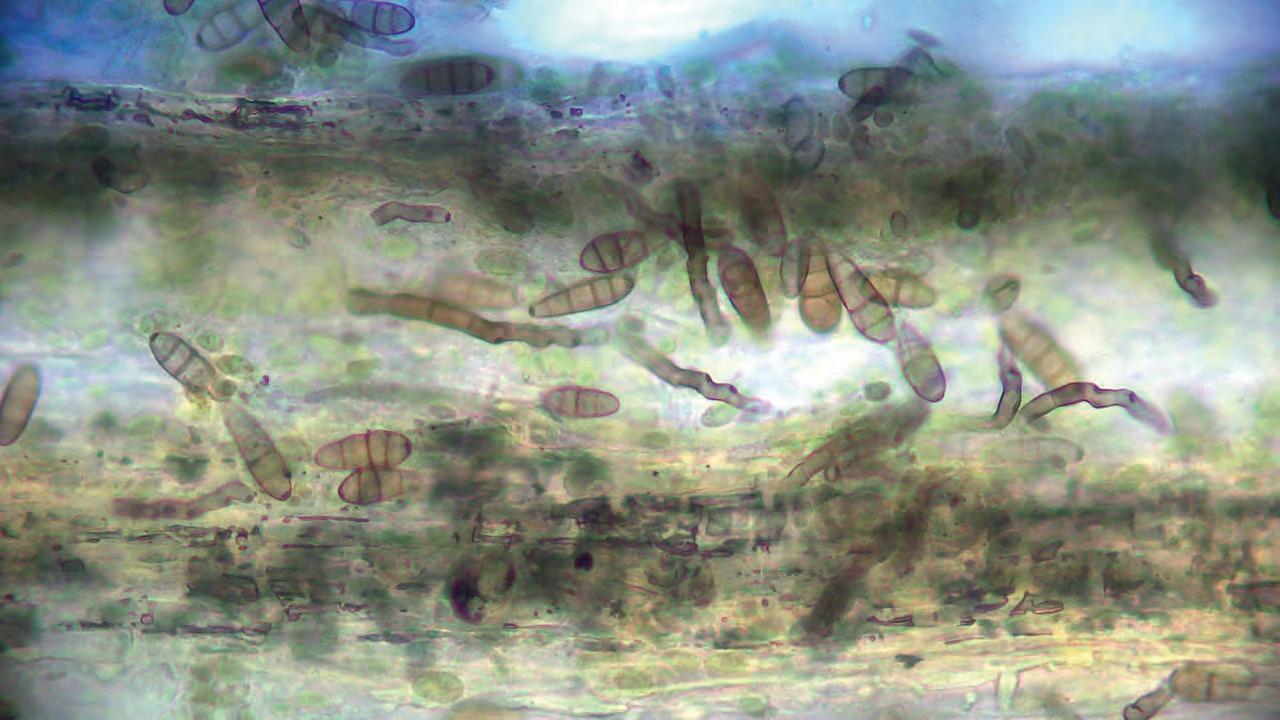
Drafting a concise article on turfgrass diseases in the United Kingdom is challenging due to the topic’s extensive scope and numerous variables.
This article aims to offer clear and practical insights, serving as an introductory overview for those new to understanding turfgrass diseases or as a refresher for seasoned professionals, although it does not encompass every aspect or claim to be exhaustive in its coverage.

Here, key questions addressed include: What defines a turfgrass disease? How do these diseases impact sports turf? What are the components of disease development? How do diseases transmit? How can we effectively prevent them? What is the role of fungicide use? And, what are common UK Turfgrass Diseases?
Turfgrass diseases are symptoms and signs indicating that the turf is damaged, typically due to an infection by a pathogenic agent. These pathogens, which can be viral, bacterial, fungal, oomycetes, algal or nematodal, are parasitic and antagonistic, harming the turfgrass while completing their lifecycle. As microscopic organisms, these are difficult to identify until the symptoms on the turf are presented. At times, an identification may only be determined by microscopy or more accurately by DNAanalysis. Apps on mobile devices are emerging with functionality to assist turf managers potentially identify and predict disease onset. Although fungal pathogens are the most common concern, nematodes, bacteria and oomycetes can also damage turfgrass. It is important to note that not all these organisms are harmful; some have beneficial or mutualistic relationships with turfgrass. Understanding these beneficial associations can be valuable in developing biological approaches to disease control too.
Turfgrass diseases can significantly affect the playing characteristics of sports turf by compromising the surface’s integrity. Diseases can cause issues ranging from root deterioration and thinning turf to large bare areas. For instance, root diseases like Take-All Patch and Pythium Root Rot, and foliar diseases like Red Thread and Microdochium Patch, can severely damage turf. Diseases often interact, such as Anthracnose with Microdochium Patch, and can be associated with pests or nutrient deficiencies. Some diseases, like Yellow Patch, may be unsightly but do not necessarily affect surface integrity. Understanding which diseases

The onset of turfgrass diseases typically requires the interaction of three key components: a susceptible host, suitable environmental conditions and the presence of a pathogen. This “disease triangle” is fundamental in plant pathology. Environmental factors often include temperature, humidity, moisture, light availability, thatch conditions and pH levels. However, even with ideal conditions and the presence of a pathogen and susceptible host (turfgrass species), a disease may not always
Above Here, Fescue grasses withstanding infection of Take-All Patch fungal pathogen (Gaeumannomyces graminis). Mainly infected bent grasses dying off. An important disease to control on new root zone constructions.
develop due to the complexity of nature and turf management.
Disease Transmission and Prevention
Pathogens can be transmitted through water, plant and soil material, machinery, equipment, footwear and even on the seed coat. Some pathogens remain dormant in the soil or thatch layer for seasons, striking when conditions are favourable. Understanding the susceptibility of different grass species to specific pathogens is crucial for disease prevention. Many turfgrass pathogens are host-specific, infecting only certain grass species. For example, TakeAll infects Bentgrass roots but not Fescue. Breeders have developed varieties within species with genetic resistance to certain diseases, enhancing disease prevention efforts. Prevention starts with this type of
Anthracnose (Colletotrichumcereale,C.graminicola)
Bacterial Wilt / Etiolated Tiller Syndrome (Xanthomonastranslucens)
Brown Patch (Rhizoctonia solani)
Dollar Spot (Clarireedia bennettii)
Fairy Ring (Basidiomycetefungi) (notatrueturfgrasspathogen)
Gray Leaf Spot (Pyriculariagrisea)
Leaf Spot and Melting Out (BipolarisandDrechsleraspp.)
Microdochium Patch or Pink Snow Mold (Microdochium nivale)
Pythium Blight (Pythiumspp.)
Red Thread (Laetisariafuciformis)
Rusts (Pucciniaspp.)

biological genetic selection of resistant grasses. This information is freely available through independent guides (e.g. British Society of Plant Breeders Turfgrass Buyers Guide, turfgrass-list. org and ntep.org), although not all varieties are easy to find or are listed. Further to this, there are cultural and other biological measures to
Annual meadow grass, Creeping Bentgrass June-September
Perennial Ryegrass, Creeping Bentgrass, Smooth-stalked Meadowgrass, Annual Meadowgrass June-September
Perennial ryegrass, Bentgrasses June-September
Fescues, Bentgrasses and Annual Meadowgrass April-October
All turf species July-September
Perennial ryegrass July-September
All turf species All year round
Annual Meadowgrass and Creeping Bentgrass, Perennial ryegrass, Smooth Stalked Meadowgrass November-May
Perennial Ryegrass, Creeping Bentgrass, Annual Meadowgrass, Fine-leaved Fescues June-September
Perennial Ryegrass, Fine-leaved Fescues March-November
Smooth-stalked Meadowgrass, Perennial RyegrassAugust-November
Take-All Patch (Gaeumannomycesgraminis) Bentgrasses April-July
Waitea Patch (Chrysorhizazeae)
Yellow Patch (Rhizoctonia cerealis)
Yellow Tuft (Sclerophthoramacrospora)
Creeping Bentgrass June-August
Creeping Bentgrass, Perennial Ryegrass, Annual Meadowgrass June-October
Creeping Bentgrass, Smooth-stalked meadowgrass, Annual Meadowgrass, Perennial Ryegrass April-December

prevent disease. Mainly this involves managing conditions associated with disease outbreaks, such as removing decaying plant material (e.g. thatch removal), improving drying conditions of the turf environment (e.g. subsurface and surface aeration and airflow/movement in the microclimate), using appropriate seeding rates at establishment, controlling irrigation to avoid over- or under-watering, and managing fertiliser inputs to avoid excessive or inadequate inputs for optimum turfgrass health. Certain micronutrients may assist in controlling diseases, e.g., iron for Microdochium Patch and






“The CS Pro has transformed the mowing side of our business!”











manganese for Take-All suppression. Physical activities can influence disease onset, for example, poor quality of cut may lead to disease. Interestingly and counterintuitively, physically rolling fine turf has been shown to reduce the onset of Anthracnose disease too. Biological control of pathogens is a growing area, with beneficial bacteria like Bacillusspp. and beneficial fungi like Trichodermaspp. known to suppress a range of fungal pathogens. These may be applied on to the turf as a spray or in a granule/powder form. The success of this type of inoculation is an area for further investigation,

Left
Red Fescues and Perennial Ryegrass appear to have become increasingly susceptible to Red Thread (Laetisaria fuciformis). Once a minor issue, this progressive disease has risen in both prevalence and severity. Management typically involves applications of nitrogen fertiliser and measures to prevent drought, followed by systemic fungicide treatments if necessary.
















Above DNA-analysis from an established Perennial Ryegrass Pitch without symptoms. Presence of four pathogens identified for preventative management.
as this may be site-specific. It’s worth repeating, these are regarded as preventative and not immediate curative solutions when symptoms are present. The use of a fungicide may offer a comparatively efficient effect, especially when planned correctly, however, their use should not be relied upon. A mix of all these approaches, or ‘integrated’ approach, is advisable with the use of a fungicide when the pathogen is present or at least strongly forecasted, based on disease pressure.

Below
Disease infection at a poorly cut leaf blade of Perennial Ryegrass. Highlights the importance of cut quality to prevent infection.
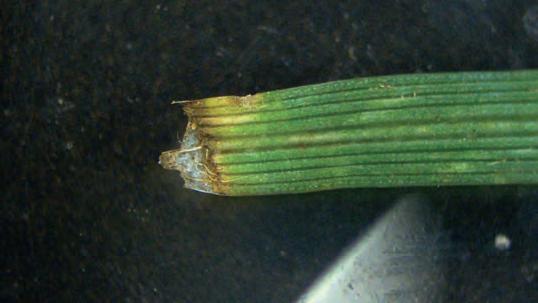
Fungicides have been an effective and a costefficient method for maintaining high-quality turf surfaces, providing assurance and a high level of control. There are multiple application methods and modes of action (time of year). The use of ‘preventative’ fungicides relies on application at early onset or based on disease pressure predictions (e.g. a disease model). The timing of application and accurate identification of target disease to label listing is critical for optimal control. The use of ‘curative’ fungicides does not recuperate tissues (leaves, roots, shoots) to become healthy; they protect
Dr. Jonathan Knowles is the Head of Sports Turf Academy at Leicester City Football Club, where he spearheads initiatives in sports turf education, research and development. His role encompasses providing expert consultancy and advisory services in sports turf management. A focus of Dr. Knowles’ work is the advancement of sports turf education, with a particular emphasis on turfgrass pathology and diagnostics. Through his leadership, the Academy aims to enhance the knowledge and skills of professionals in the field, promoting best practices and innovative solutions in sports turf management.
uninfected tissues from further infection. Curatives are typically higher in concentration or applied at shorter intervals. The main two modes of action are contact and systemic. Contact fungicides simply coat plant tissues and protect against infection, these are also known as ‘protectants’. Systemic fungicides penetrate into the plant and also known as ‘penetrants’. Penetrants move within the plant, typically in the transpiration system, upward in the xylem tissues. Further to this, there are also localpenetrants that pass through plants tissues (translaminar). Fungicide use is increasingly scrutinised due to environmental and societal concerns, and reducing the applications of fungicides is widely acknowledged as a key turning point in sustainable turfgrass management. Disease resistance is a risk that further exacerbates the constraints of fungicide use, including difficulties with future efficacy. Manufacturers of fungicides and organisations such as the Amenity Forum invest heavily in research and education for operatives to perform best practices. It is highly advisable that these shared practices and educational updates are taken and utilised.
Effective management of turfgrass diseases involves understanding the disease triangle, modes of pathogen transmission and specific susceptibilities of grass species. Combining biological approaches, genetic resistance and judicious use of irrigation, fertilisers and fungicides can help maintain healthy turfgrass in the United Kingdom. Equally important is staying up to date with new and emerging advances in integrated disease management to ensure sustainable turfgrass management.



























































© Richard Buggs

Alex McKelvie, Senior lecturer arboriculture Myerscough College, helps us see the wood for the trees.
Ash dieback is fungal disease affecting the common ash tree (Fraxinus excelsior) and other Fraxinus species. It is caused by a fungus called Hymenoscyphus fraxineus which is native to eastern Asia. The disease was first found in England in 2012, although research has shown that it is likely to have been present since at least 2005.
Ash trees make up 12% of Great Britain’s broadleaved woodland, and are often found in parks, gardens, hedgerows and roadside margins. Ash dieback is present in most parts of England, although the severity of the disease varies locally.
Ash is one of our most useful and versatile native tree species, providing valuable habitat for a wide range of dependent species. It can grow in a variety of soils and climatic conditions. The ‘airy’ nature of its foliage allows light to penetrate to the woodland floor, encouraging ground plants and fauna. A number of insects,
other invertebrates, lichens and mosses depend wholly on ash for habitat.
Identifying and symptoms
Ash dieback has the potential to cause significant damage to the UK’s ash population, with implications for woodland biodiversity and ecology, and for the hardwood industries. Experience in continental Europe, which is now being seen replicated in the UK, indicates that it can kill young and coppiced ash trees quite quickly. However, older trees can resist it for some time until prolonged exposure, or another pest or pathogen, such as Armillaria (honey fungus), attacking them in their weakened state eventually causes them to succumb.
Infection can lead to leaf loss and dead branches throughout the crown of ash trees, and clumps of new growth towards the centre of the crown. In areas of high infection, the fungus can cause lesions at the base of the tree, making it more susceptible to secondary infections, such as by Armillaria fungi.


• From the foliage, the fungus can colonise the branch structure of the tree, causing dieback. Trees may respond by producing new growth towards the centre of the crown (see figure 2).

It is recommended that you familiarise yourself with the symptoms of ash dieback so you can assess the health of your ash trees and the severity of the infection in your area. The best time to survey is in the summer, when the symptoms are more obvious.
• Spores from the fungus travel on the wind and infect foliage, causing brown patches spreading towards the central leaf stalk and premature leaf loss (see figure 1). In some cases, the fungus will go on to colonise the branch.
• Lesions are caused as the pathogen colonises branches of a tree. They are typically diamond shaped (see figure 3 on page 38).
• Among the first symptoms that an ash tree might be infected with H. fraxineus is blackening and wilting of leaves and shoots (see figure 4) in mid to late summer (July to September).
• Particularly in woodland, secondary pathogens such as honey fungus can colonise trees weakened by ash dieback and cause root or stem rot (see figure 5).

Because ash trees have many genetic variants and occur right across the UK, they come into leaf at different times in the spring: sometimes as late as the end of May. Trees in the colder north flush later than trees in the warmer south. Some ash trees will break-bud, or flush, earlier than others, and some buds will produce flowers rather than new shoots. Some variation will be more apparent in older trees. So, if an ash tree does not have any leaves in April and May, it does not necessarily mean that it is diseased or dying, but by mid-June all healthy ash should be in full leaf.
In the autumn, you might see clumps of sometimes dark-coloured ash keys, or seeds (see figure 6 on page 42), retained on the trees after the leaves have fallen. This is quite normal, but from a distance they can be mistaken for the blackened leaves which can be a symptom of the disease.

You are not legally required to do anything if you have ash trees that have ash dieback. However, the fundamental legal requirements under tort law, ‘a duty of care’, requires tree owners to identify what practical tree management measures they should take to meet their duty of
care, should a tree fail or partially fail. Public safety must be the priority, so there are implications for those managing trees which become infected. The disease spreads and weakens branches and stems, which will start to fall, meaning that a tree owner may be negligent in their responsibilities if they do nothing.
It is important to remember, the owner of the land or nominated person for health and safety will be liable for prosecution if a dangerous tree harms someone or their property













There are financial and practical implications relating to this disease that will need to be addressed. It is therefore vital that people and organisations responsible for managing ash trees and woodlands containing ash understand the implications and take timely, site specific and proportionate action to prepare for this.
...This is highly likely with trees affected by ash dieback, and with the number of visitors and workers on a golf course, the implications of not managing ash dieback is a concern to clubs in the sports turf industry.
Along with legal implications of ash dieback, the impact on our landscape will be severe. Studying the impact of the disease experienced in Europe, the spread of the disease in the UK will mean that a significant number of ash trees will be lost from our urban and rural areas over the next twenty years. Estimates forecast that up to 75% of our ash tree population will be lost from UK landscapes overall.
Golf courses play a vital role in sustaining wildlife in wooded areas. The ecological implications of the loss of ash trees will change wider biodiversity and habitat composition. The impact on populations of other plant and animal species such as bryophytes, invertebrates and lichens that use ash trees for feeding, breeding or as habitat will be hugely damaging.
Infected trees that are in areas with high levels of public access, or areas of the golf course where players stand waiting e.g. tees and greens, need to be monitored carefully for risks to safety. There is currently no cure for ash dieback, so a responsible tree owner or manager needs to assess the risk and prescribe remedial tree work to take place, such as felling or pruning of dead and dying trees.
Before undertaking any works, remember to check if you require a felling licence. You will need one if the tree is:
a) Protected by a tree preservation order (T.P.O.)
b) Located in a conservation area
c) If the tree, or trees felled, amount to 5 cubic metres of timber by volume
It is important, when recommending works, that a competent and qualified surveyor is appointed to undertake a formal tree survey of high-risk areas, and work is then undertaken by qualified arborists.
It just leaves me to thank Alex for his time and insight into what has to be one of the most impactful issues related to our industry at the moment and in the future.
Article by Phil Helmn.


JACOBSEN® CREATES SOLUTIONS THAT ARE BETTER FOR PEOPLE, PROFIT AND THE PLANET

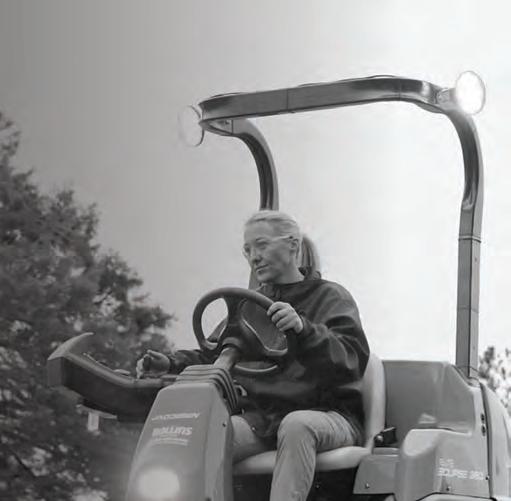




It must come as a shock to find yourself kicked out of what has been your historic home for seventy-eight years... only to be kicked out of your second home just a few years later. This is exactly what happened at King George V Bowling Club.


The King George V public house, a Grade-II listed building in the Northfield area of Birmingham had been the home of the Bowls Club since 1937. Their predicament began when the pub was sold to a new landlord back in 2014, when it became clear that the new owners were not interested in supporting the bowling club. After many internal meetings with the new landlord, and even a public protest gaining much coverage in the local press, the club found themselves homeless.
A new venue was found at the Tally Ho - the West Midlands Police Sports & Social Club. The venue is situated opposite Edgbaston County Cricket Ground and nestles in six hectares of prime land adjacent to the busy Bristol Road and Pershore Road.
Fast forward to 2023 and the club were notified that members of the public would be unable to access the facilities at the Tally Ho any longer. The landlord wanted all bowling to stop with immediate effect but, thankfully, further negotiation gave seven months grace for the club to find another venue.



Mike Pritchard, greenkeeper at the club, said; “The major problem was trying to find another venue, as we obviously wanted a green in a reasonable condition… and so the Selly Park Tavern journey commenced.”
A new challenge begins
The conditions at Selly Park weren’t as ‘reasonable’ as Mike had hoped, as the green had been unattended for five years. Last year, they started renovation and rejuvenation in August, with multiple cuts of the green to get it down to a good level.
Mike explained the process: “We vertidrained and verti-cut the green, then, in early September, we started the process of adding 20 tonne of rootzone and 5 tonne of topdressing. We covered it with germination sheets and saw the first signs of life within a week.”
The green at Selly Park wasn’t the only thing that needed a glow-up. The pavilion needed plenty of work to allow for use and Mike praised his wife for her contribution: “A few members have renovated it and painted it to make it more welcoming.”
An outside helping hand



Mark Allen from Agrovista Amenity has supported Mike for over twenty years at various bowling greens. He was full of praise for the work that had been done and highlighted how he had contributed to the project: “Mike is a committed volunteer, and he has worked extremely hard. It was dilapidated and overgrown and that’s not something that volunteers often have to deal with, so I wanted to offer some professional guidance. This has been much more than maintenance; the club have had to go back to square one and create a bowling green from scratch.”
Mark brought in renovation techniques more usually used in other sports such as football and cricket; “It is rare to carry out such radical operations to a bowling green because clubs aren’t usually placed in this situation. It was nice to oversee the project from a blank canvas.”
After the first month, I realised that we were going to produce something great
Contractor and friend of the club, Andy Hartwell of Lush Lawn Care, also praised the work that has gone into restoring the green: “There has been a lot of work to get the green to where it is today and I have supplied machinery, help and advice. Most bowls clubs can’t afford to have heavy duty kit because they don’t use it

There has been a lot of work to get the green to where it is today
have received donations from members and compensation from the WMP Sports and Social Club. It all helps. We have spent £9,000 in total and it wouldn’t have been possible without the kind donations.”
Despite the challenges with the green, Mike feels lucky that the venue was available: “If you are prepared to put the effort in, you will end up with a good green. It has been a team effort with many members helping but, in particular, Geoff Bagnall who shares greenkeeper duties with me - who I couldn’t have taken on this task without.”
Success on and off the green


enough, but we needed to hit it hard and create a completely new green. We slot-seeded as much of the green as possible, but we had to do everything twice; double scarified and double overseed.”
Mike had doubts from the moment he stepped foot onto the Selly Park venue and never imagined the green being at such a high standard. “I just couldn’t visualise the success. It was Mark and Andy who pushed me to believe that we could get a decent green. After the first month, I realised that we were going to produce something great.”
The club have had sponsorships and donations from several sources and Mike reflected on the boost this has given: “The Central Co-op and British Crown Green Bowling Association helped us a lot, plus we
Mike was worried about losing members due to the move: “I wanted to have the green in the best condition to keep members, which we have achieved, as well as new members and the club has won the Warwick and Worcester league for the past two years.”
“When the previous Selly Park Club folded a few years ago, quite a few of their members came and joined us at the Tally Ho. I think a few of them were concerned about returning, however, the feedback has been positive… which is unusual from bowlers.”
The club had their first game on the green in a friendly against Tanworth in Arden Bowls Club and Mike was pleased with the reaction from the visitors: “They were complimentary of the work and a few of them even posted on social media about the quality. It’s a credit to the club.”
Mike and his wife Bev have decided that this is their ‘last move’. He thinks that they have managed to turn Selly Park into their home again and laughed as he summarised: “We will see how the season goes and then judge the surface.”
Article by James Kimmings.













The uptake of sustainable and responsible practices in grounds maintenance, especially in outdoor power equipment (OPE) is increasing rapidly, as battery-powered tools are swiftly gaining favour with many professionals over petrol-powered alternatives.
While petrol-powered equipment has long been the ideal choice for handling tasks in large areas or with tough vegetation, the convenience of battery-powered equipment has become increasingly popular and offers a quieter, more pleasant outdoor experience. As this landscape evolves, battery-
powered OPE represents a move towards more eco-conscious and user-friendly outdoor maintenance solutions, while matching and outperforming the petrol equivalents.
Rhys Adams, national sales manager OPE at Milwaukee Tool, explores some of the benefits of battery over conventional petrol-powered tools, highlighting the environmental, health and safety, and cost-efficiency advantages these


products have to offer groundskeeping and landscaping professionals.
The first benefit when adopting batterypowered OPE lies in its significant positive environmental impact, supported by research from the University of Birmingham, which found that widespread adoption of electric or batterypowered OPE in urban areas could significantly improve air quality. This is because reduced emissions from electric tools contribute to lower concentrations of urban pollutants, which benefit public health and the local environment.
Yet, despite the clear benefits of using battery-powered OPE, many professionals still use petrol-powered tools to maintain public areas, leading to occupational levels of exposure that can damage workers’ health and the surrounding community; which means more needs to be done to highlight the options available to groundskeepers.
Traditional petrol-powered tools are known for their emissions, which contribute to air pollution and leave a considerable carbon footprint. In fact, according to one study from the United States Environmental Protection Agency (EPA), a single petrol-powered lawn mower can produce the same amount of air pollution as 11 newer cars driven for an hour.
In stark contrast, battery-powered OPE operates with zero emissions, leading to cleaner air and a marked reduction in environmental pollution. Research conducted at
Williams College found that, over 10 years.....
some electric mowers can release approximately 474,500 to 693,300 pounds fewer CO2 emissions compared to their petrol counterparts.
This research highlights that the transition to battery-powered OPE marks a significant step forward in environmental sustainability. By replacing conventional petrol-powered tools with a battery-operated equivalent, we can effectively curb harmful emissions and directly improve air quality. This reduction in emissions not only promotes environmental well-being but also gives real benefits to communities.
In addition to environmental improvements, battery-powered equipment offers several benefits to support a healthier and safer working environment. Throughout their careers, landscaping professionals commonly experience injuries or health issues related to the use of petrol-powered tools.
One frequent hazard associated with petrolpowered OPE is the significant health risks linked to exposure to toxic fumes like benzene, which can cause breathing issues leading to other long-term respiratory problems. Since no harmful emissions are produced when using battery-powered tools, they’re considered a much safer option compared to their petrol counterparts, helping to protect not only groundskeeping professionals’ health but also those around them.
There are also concerns from across the industry, and the Health and Safety Executive (HSE), surrounding the reduction of noise pollution to protect workers’ hearing. According

to the Control of Noise at Work Regulations 2005, workers must not be exposed to noise levels exceeding 87dB to ensure user safety. However, petrol-powered tools often exceed this threshold, posing a danger to human hearing. In contrast, battery-powered models are designed to operate well within or far closer to this limit; helping to reduce noise pollution while lowering the risk of noise-induced health issues among workers and the general public.
By switching to battery-powered OPE, professionals can make maintaining outdoor spaces a cleaner, more sustainable and safer job, which protects workers while benefiting the wider community by creating a quieter and more pleasant living environment for all.
Beyond the health and environmental benefits, battery-powered tools offer remarkable cost efficiency and convenience. And, while they often start at a higher price point, the rising costs of petrol and the ongoing maintenance demands of these engines make battery tools a financially sensible choice. Battery-powered OPE eliminates the need for messy fuels, reduces maintenance costs and offers a longer lifespan, resulting in significant savings over time. This translates into lower operational costs and less downtime, as in the UK alone,
collectively groundskeepers use over 600,000 litres of petrol every year. By transitioning to battery-powered systems, there’s no longer a need for frequent trips to the petrol station or dealing with engine maintenance, providing a more streamlined and efficient way to work.
At Milwaukee Tool, we have listened to the needs of professionals and have developed a range of tools and accessories centred around our flagship M18 battery platform, combining professional-grade power with cordless convenience. The M18 family includes over 290 solutions to enhance efficiency, durability and compatibility.
At the heart of the M18 battery is our REDLITHIUM technology, which ensures exceptional performance and durability even in extreme conditions, including temperatures below -20 °C. It operates 20% cooler in hot climates than standard lithium-ion batteries, delivering consistent, fade-free power for reliable productivity and extended battery life.
The M18 battery range also features our REDLINK Intelligence system, enabling seamless communication between the battery and equipment, and optimising performance, protection and productivity to meet groundskeepers’ needs.
We prioritise environmental sustainability and user health by significantly reducing CO2 emissions, noise and vibration for the user, compared to petrol-powered options, creating cleaner, safer workspaces.
The shift towards battery-powered OPE marks a significant advancement in landscaping practices. By offering benefits, such as environmental conservation, improved health and safety, cost efficiency and cutting-edge technology, companies like Milwaukee Tool are at the forefront of the future of landscaping and outdoor maintenance.
To discover more about the M18 battery technology, click here or to explore Milwaukee Tool’s full range of outdoor power equipment, visit uk.milwaukeetool.eu

Advert 179x130.pdf 3 19/06/2024 20:54:24


















































Granting wildlife the habitat to optimise their biological niche is an issue looming larger in the strategies of sports, leisure and amenity operators and managers.
Multidisciplinary working can realise current thinking on species extinction, an issue set to enter the election battleground, most notably among the young.
Wildlife trusts across Britain, partnering local authorities and government agencies, are active in helping improve existing habitats to foster greater biodiversity and fashion new ones.
“Sports facilities can do so much to help nature recover and tackle climate change if
they’re managed sympathetically,” says Barnaby Coupe, land use policy manager at The Wildlife Trusts.
“Avoiding pesticides and weedkiller is a great way to start – these chemicals can be dangerous to insects and polluting to local streams and rivers,” he cautions.
“Additionally, managing habitats around the edges and interlinking areas of golf courses and sportspitches with nature in mind can make a huge difference for wild plants and animals.”
“Let the grass grow long across large swathes,” he advises, “and only cut it once in late


summer, taking care to rake up and compost all the cuttings. Doing this will reduce fertility and allow wildflowers to grow, which is crucially important to provide food and shelter for threatened insects.”
“We’re in a nature and climate crisis,” Barnaby continues, “and changing the way we manage land to be more sustainable can play an important and beneficial role in helping pollinators and animal populations recover.”
“It also makes for more beautiful surroundings. Large numbers of sports facilities have vistas of oxe-eye daisies, wild orchids and buttercups at this time of year.”
Referring to the worrying trend of increasingly wet weather and intensity of precipitation, he notes: “Natural habitats are also better at storing water, which have longer vegetation and better soil structure to soak up water in times of high rainfall.”
“This is especially important as we see the challenges of extreme weather events increase with climate change,” concluding: “The benefits of managing land to improve nature are multiple – give it a try!”
Rivers are ready-made wildlife corridors, under threat on at least two fronts – pollution from wholesale sewage discharge and shifting patterns of heavier rainfall, one reportedly the effect of the other. Wildlife trusts have notable examples of success to report in turning the tide by working to let land hold more water to lower flood risk.
In South Yorkshire, natural flood management measures in the Limb Brook Catchment help protect Sheffield and the region, while

With Chesterfield’s crooked spire as a backdrop, the former Avenue heavy industrial coking plant was restored to provide the space for both wildlife and people. Re-meandering of the River Rother created a country park mixing grassland, wetland and newly planted woodland habitats.
Five years later, the site has matured and Derbyshire Wildlife Trust, land managers since 2019, reports a welter of bird species populating the park. Visitors regularly spot kingfishers and lapwings in the wetlands, while flocks of goldfinch feed in the large meadow areas, it adds. The wet, lush green environment also attracts great crested newts and grass snakes. Large multi-user paths suit running, cycling and horse-riding and sportspitches serve local teams.


generating fresh wildlife habitats.
Popular Whirlow Playing Fields provides floodwater storage following a naturebased solutions (NBS) demonstrator project, which united the Environment Agency, Sheffield City Council and Sheffield & Rotherham Wildlife Trust.
Under the Upper Don Source to Sea programme, the works help store water and slow
movement to limit chances of flooding in at-risk sites downstream in the river Don.
Facilities like Whirlow Fields usually would be drained artificially, the Trust explains, with rapid run-off of water channelled to nearby watercourses - here the Limb Brook, a tributary of the Sheaf, in turn a tributary of the Don. Heavy rainfall can add to existing high flows, causing flooding downstream.

























Proposals for new pitches now require measures to dampen flow. This project sought to do this retrospectively by accessing drainage systems and bringing the flow to the surface as streams - directing it into six attenuation ponds to hold and slowly release excess water - and swales, shallow, grassy channels slowing and directing flow.
Rainwater moves more slowly once it hits
the ground, as it flows through long vegetation and snakes around channel bends - ponds temporarily holding off water during storms.
“Bringing water to the surface and out of pipes can create a new dynamic and biodiverse landscape,” the trust says. “These features and wildflower meadow and hedge planting support wildlife including birds, insects and amphibians, as well as creating resilience to climate and ecological emergencies.”
Sheffield Hallam University undertook engineering design of the flood storage reservoirs and attenuation ponds, also assisting with ecological and landscape history assessments.
Water movement changes were monitored








Above Avenue Country Park, heat of industry cooled for nature.
Below Peace reigns at Avenue Country Park.
onsite via a large citizen science component involving the local community, and in the river with hydrology equipment.
“Even in its early stages, with not all ponds in place and some bare areas where vegetation had not yet fully colonised, the scheme was working,” the trust reports. “Water flows through the swales constantly; and during recent extreme rainfall, the ponds held a significant amount, slowly releasing it into the swale systems, which directed the flow into the bund at the bottom of the fields where it dissipated into the woodland.”
“The work on Whirlow Fields allows us to capture more water during extremes while holding some water for wildlife makes the site, and city, more resilient against flooding, and resilient for wildlife.”
severe one, which may only happen every 30 years – “a clever way to future-proof Rotherham, Sheffield and other communities downstream, while providing a wildlife-rich landscape for everyone to enjoy.”
Delivering varied interventions along the whole of a watercourse and slowing flow provided a chain of water-dependent habitats to improve biodiversity, said Anthony Downing, Environment Agency Catchment Coordinator, Environment Programme, speaking when works were completed.
“Knowledge we gain from the project will inform how the Source to Sea programme will deliver nature-based solutions across the River Don catchment.”
The pond control design lets managers decide if they want to capture water for a common flood event like annual heavy rainfall, or a

A World Heritage Site is mooted for the wildlife reserve on the West Kent Golf Club estate, near Orpington, signalling the importance of this habitat. A stone’s throw from Down House, where Charles Darwin developed his seminal work on the Origin of Species, the WHS would be aptly coined – Darwin’s Landscape Laboratory.
Managed by London Wildlife Trust since 1987, under an agreement with the golf club to conserve and enhance its value for wildlife, the Eastern bank sits in rare chalk grassland, scrub and woodland, and numbers some 28 species of butterfly, which the unusual mix of wildflowers attracts, the Trust explains. “His writings suggest the reserve helped inspire Darwin’s theory of evolution by natural selection,” adding, “Rotational meadow cuts and selective burning help control invasive grasses and sustain high species diversity.”
At least three other reserves rest within six miles of West Kent, offering opportunities of connectivity across all four sites, perhaps.
gains
Technology will increasingly steer a path to more ecologically inclusive habitats, but joining the

dots between differing data sets and systems holds the key to viewing and assessing currently sustainable regions by crucially pointing the way to strategically planning wildlife corridors, particularly in the built realm.
The HUGSI.green (Husqvarna Urban Green Space Index) initiative, run by the power tools and turf machinery manufacturer, holds the promise of helping realise such a future, linking data on the percentage of green cover in more than 200 cities in Europe and worldwide,


to street level snapshots of urban green space and development.
League tables of greenest cities emerge and, importantly, shifting patterns and percentages of canopy cover witnessed over time to also provide a nature positive/nature negative index.
Seen in aerial view, planners, architects, designers and facility operators can see how what they do fits into the wider environment. What are now isolated pockets of green could link up to create corridors to foster greater mobility for wildlife.
Enterprising schemes such as the Weald to Waves initiative, stretching from Surrey to the South Coast, show what’s possible with joined-up thinking and how sports sites can play a critical role in wider action to make land wildlife friendly.
A great deal of next-level thinking is going into developing an integrated strategy to connect the many pockets of nature-healthy habitats spread across the UK. Challenging but creative times ahead for planners and practitioners.
Article by Greg Rhodes.







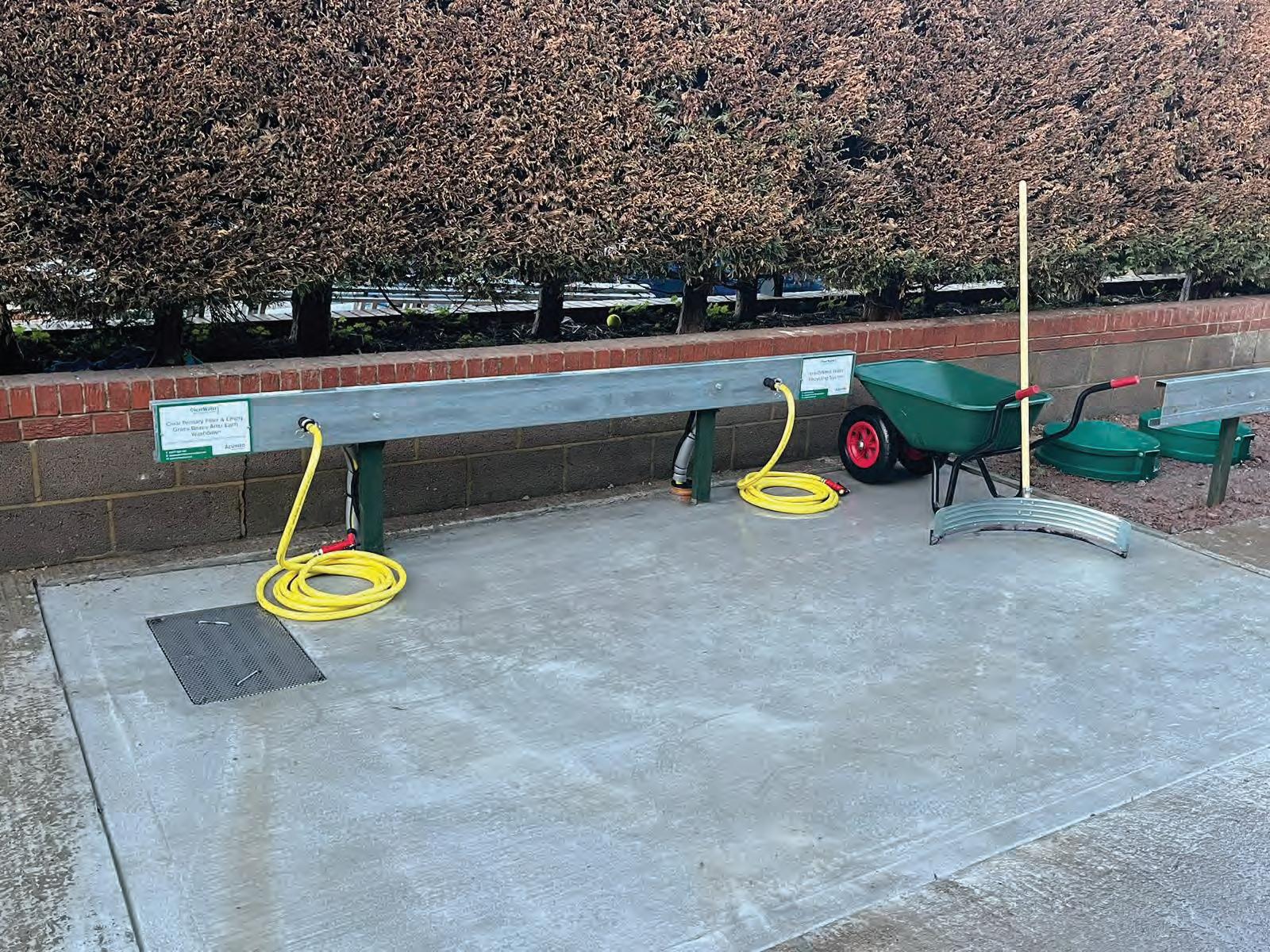



As vandalism increases across the industry, Pitchcare spoke to Dave Collins about bike damage at Lickey Hills Golf Club.

Dave Collins Head Greenkeeper
As a head greenkeeper, you never want to see tyre marks on your greens. Dave tells us about how the club aims to rescue the surface.
How long has this been happening?
Unfortunately, Lickey Hills has always been victim to vandalism. The course is a council owned public right of way which makes it difficult for Dave and his team to reduce the number of times this is happening. “Last year we had five greens vandalised; one of which was on Christmas Eve. Then, this year we had further damage just before Christmas which we managed to rescue.”
“Back in March, we had six greens damaged in two nights. Some of them were superficial damage and we were able to rescue them, however, a couple of them were a lot worse. Given the time of year, it was really hard to achieve germination, but we had to stay positive we would get the greens back. Usually, vandalism only happens once a year but, when they do five or six greens in one night, it can hamper the course for months.”
Repair and restore
Due to the damage happening in the winter; Dave was limited to the amount of recovery the club could do on the greens. He explained: “We cleaned off all of the debris, then seeded and topdressed to fill in the scars, which seemed to be the most effective method. For some of the deep damage, we had no choice but to
re-turf, but unfortunately we can’t do that on all the greens.”
Golfer reaction
To the golfers, the damage on a green always looks worse than the job needed to fix it and the team are usually able to restore the greens quickly. Dave told us about some of the player reactions to the damage: “We are a pay and play, which means we get a lot of visitors, but generally people are always supportive when things like this happen. Some of them want to come in and be vigilantes, but we can’t allow that, obviously. You get golfers who support you more because you are having these problems, but it’s hard to stay positive.”
It’s mentally exhausting
As well as the physical damage that vandalism causes, it also has a mental knock on those trying to produce the best playing surface. Dave reflects on how it has made him feel: “It is your sweat and tears and it’s heartbreaking. You have worked on the greens all year in preparation for the season and someone’s idea of fun has ruined that. If it was a one off, I would be really angry and upset, but when you have it as much as us, it’s in your head. The anxiety increases because you are always thinking about the damage.”
“When it happens over and over again. You start to become numb and it never gets easier. You still have to go out and repair it. We want to come in and undertake jobs that we’re here to do, but when you come to work and the first



tify areas of your property that may be vulnerable to forced entry and have them made more secure, paying particular attention to windows and doors
onsider reinforcing back doors, windows and weak points where entry could be gained

Above
The damage caused has been significant, but the team have turned it around.
thing you check is to see if there has been more damage, that is quite sad.”
He highlighted the impact on his staff: “They have a huge amount of pride in their work, so when this happens, they are on edge. We pick each other up and go and get the job done.”
As well as being head greenkeeper at Lickey Hills, Dave also works part-time at his beloved Aston Villa. He describes a match day as an anxiety relief: “It is a blessed relief to go and help down at Villa. You get a complete break from the worry of damage, which has been a major bonus to my mental health.”
According to police information, the individuals causing the damage are teenagers. Dave thinks that education is the way forward: “We are going to do the BIGGA First Green initiative to educate youngsters about greenkeeping and we use social media to widen the awareness and implications vandalism has.”
e sure any service doors are locked and secure when not in use
e sure you have a monitored alarm and that it’s fully operational
Ensure your CCTV works and that it provides facial recognition and good quality images, while covering any vulnerable areas. Twenty-four hour digital CCTV is also highly recommended
Bins should be stored away as these can be used to climb on to gain access to buildings, especially via the first floor
ufficient lighting around the premises can be used to deter criminals and help to improve CCTV images that are captured
Cut back any overgrown bushes or trees that surround buildings as these can provide cover for anyone who is trying to hide from view
9. In the absence of external shutters or attack-resistant laminated glass in sturdy frames, film can be applied to glass to make it more resilient.
10. Consider ways to prevent ram raiders from striking by putting large rocks, piles of soil or other obstructions in front of buildings
10. Make sure storerooms are locked and, where possible, keep equipment out of site
12. Store buggies and other ride-on equipment inside your facilities
13. Put up curtains or even large sheets of paper to stop people peering in through windows
14. Make sure keys are not left on the premises and that only designated staff have access. In case of emergency, make sure there’s a list of keyholders who can be contacted
15. Add signage to say you have removed all handheld equipment from the premises
Summer is well underway which, as greenkeepers and groundspersons, involves more time spent in the sun. This increases the risk of skin cancer and sun damage, and here we give you some tips to consider:
Reapply, reapply, reapply…
Use SPF 15 or higher sunscreen and remember to reapply it every two hours! For those working outside, it is recommended to apply more frequently.
Think about your clothing
If you are unable to wear full-body sunscreen, wear clothing with an Ultraviolet Protection Factor (UPF) rating. This rating indicates the amount of ultraviolet light that can penetrate a garment. A UPF rating of 50 or higher provides the best protection. Cover with light-coloured, loose-fitting clothing, such as long-sleeved shirts, pants and broad-brimmed hats.
Keep an eye on your eyes
The eyes are just as vulnerable to sun damage and cancer as the skin. Wear UVA and UVB protective sunglasses. When outdoors, wear sunglasses that block both UVA and UVB rays.

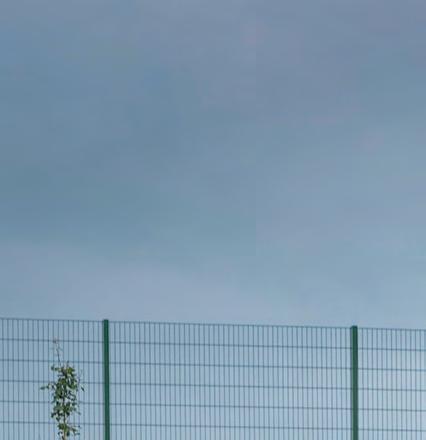
Seek the shade
While all shade provides some protection from the sun, dense tree covers and walled structures offer superior coverage to single trees and sun umbrellas. During break times you should find a cool place where you can have a drink and refresh.
Stay on top of your skin
Schedule regular skin checks with a qualified dermatologist every year. You should also perform self-examination regularly for any changes.
The best way to avoid skin cancer is to stay proactive about sun protection. If you have any concerns about your skin health or if you have noticed any changes to your skin, please don’t hesitate to schedule a skin check.
• Basal cell carcinoma: The most common type of skin cancer. It generally presents as a raised pink, red, or white patch on the skin.
• Squamous cell carcinoma: This condition is the next most common type of skin cancer after basal cell carcinoma. Squamous cell carcinomas are typically scaly, crusted patches on the skin.
• Melanoma: The rarest and most dangerous type of skin cancer. Melanomas generally appear as dark, irregular spots on the skin.















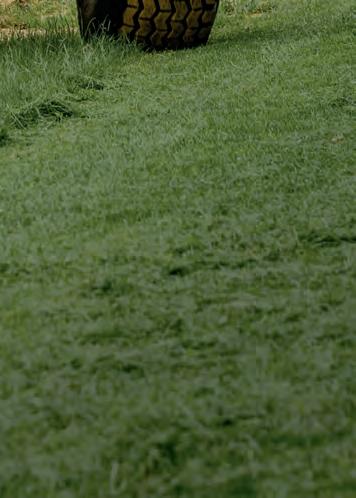


I have always had an interest in birds and working outside gives me the opportunity to keep a look out everyday for these avian wonders, but just how many birds are on your course and what can you do to help monitor them?
By monitoring birds on a regular basis, you can keep an eye out for a drop in numbers and tailor your management accordingly. I’m going to talk about a couple of ways in which you can do that.
• Can be used as a suitable replacement for cavity nesters due to loss of suitable habitat (Woodlands & Hedgerows) and old buildings
• Provide an easy way of monitoring their numbers
• Can help increase the population of some species

• Before you put any boxes up, walk the site to scout suitable locations and determine how many you could get out... you might be surprised.
• Height generally around 2-3 metres, but you can go as low as 1 metre.
• Avoid south-facing boxes.
• Open fronted boxes for Robins should be low and, if possible, hidden. Maybe by Ivy on a tree, or in the middle of a bush.
• I would advise putting metal plates around the entrance hole of the small boxes to protect from squirrels and woodpeckers.
• Starlings love boxes. Numbers have dropped so it’s worth adding boxes which could help.
• Barn Owl boxes could get occupied by Stock Dove, Jackdaw or Kestrels if the barn owl decides they don’t want it.




for
Now that summer has finally arrived, the weather should perhaps be a bit warmer. Bird life is a bit quieter, but there is still lots to look out for.
More butterflies should be on the wing now. Keep your eyes peeled for Meadow Brown, Gatekeeper, Painted Lady, Large & Small Skipper, scarcer Butterflies like White Letter Hairstreak (if you have elm around), Purple Hairstreak, Purple Emperor (mainly in Oak Woodland; adults feed on aphid honeydew and tree sap, but also animal dung and carrion for salts & minerals) and Small Copper. There might also be a few day flying moths around such as Scarlet Tiger, 6 spot Burnet and Cinnabar.

Large box for a variety of species including Stock Dove and Jackdaw and Grey
for
Sometimes a
will use these, so when you check them always have someone with you and wear head/ eye protection.
Useful links for information about the Nest Record Scheme run by the British Trust for Ornithology (BTO), how to check boxes safely and some information on boxes:
• bto.org/our-science/projects/nest-record-scheme
• bto.org/our-science/projects/nesting-neighbours/ how-monitor-bird-nests#
• bto.org/sites/default/files/bto-nest-boxes-essential-guide.pdf



Above Left Young Great Tit about 1 week old.
Right Top Treekeeper.
Right Bottom Goldcrest.
Below Young Blue Tit being ringed.
Bird ringing is a bird monitoring scheme run by the BTO in Britain and Ireland. It involves using a special tool to put a small metal ring on a bird’s leg; the ring has a unique number/code and the address of the Natural History Museum (London SW7).


creatures in your hand.
Bird ringing is a great way of identifying birds as individuals, keeping track of a bird’s movement, how far it travels and also tracks how long a bird lives for. While ringing adults, you can take other measurements such as weight and wing length and gain valuable information to track survival rates.
In order to be able to ring birds, you have to undergo specific training to get the appropriate permit/licence. Ringing is done in mainly two ways:
As part of checking bird boxes in spring, I have a C Permit that enables me to ring what chicks I find. It is always a privilege to hold such delicate
The other way of catching birds to ring them is by the use of Mist Nets; a fine net with pockets stretched between 2 poles... the birds fly into the net and are extracted safely - with no harm to the bird. Once caught, they are processed by taking measurements, weight and of course ringing them.
Mist Netting is a great way to get the public involved with finding out about the ringing scheme. By allowing local ringers to hold ringing demonstrations at your club, you can enable members to get up close to birds that they usually wouldn’t and find out more about the ringing scheme. It is a great exercise and have always been well attended.
Below are useful links to find out more about the ringing scheme and how to get started with your training:
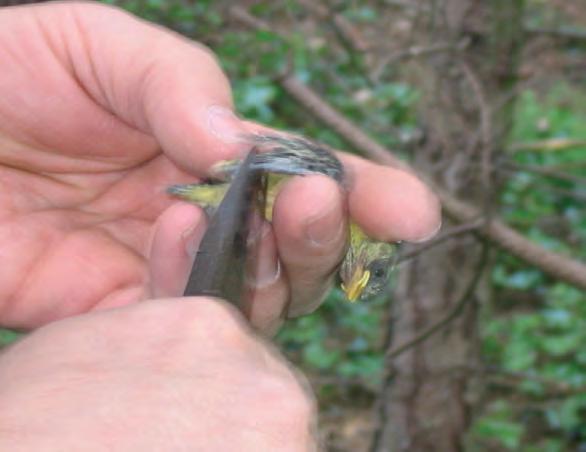
• bto.org/our-science/projects/birdringing-scheme
• bto.org/our-science/projects/birdringing-scheme/training-ring
• euring.org/

If anyone has any questions on anything in this article please contact me via email: info@theconservationbuddha.co.uk



In a world awash with data, tech that can gather and analyse it is potentially priceless for groundcare managers working in the face of stiffening pressure on resources and efficiency.

Monitoring a single machine’s activity and performance via GPS for managers to process was one of the first steps towards ‘intelligent’ operation, and major manufacturers have introduced several advances on the original concept as tech grows ever smarter in the service of turfcare.
The quantum leap now is in connectivity. If you know all about how one machine behaves, why not know everything about your entire fleet – what machines are doing where across
the sports facility, performance, maintenance schedules, repair protocols, idle time, and how the groundcare team interacts with the kit?
All parameters tethered to reveal the full 360 degree view for managers to make informed decisions based on actuals.
The major players in golf are already at it, moving from trialling to tech rollout. Carnoustie and Wentworth are early adopters of John Deere’s precision turf technology, for example, recently showcased for dealers at a German golf complex, near the Mannheim factory, that has been assessing the management system for nearly two years.
The 27-hole Golfpark Kurpfalz venue in Limburghofer demonstrated electric E-Cut walk-behind greens mowers, now available, 7700A E-Cut hybrid fairways mower and HD 200 ProGator GPS precision sprayer.



Under Connect, Guide and Manage protocols, machinery is linked to a cloud-based operations centre for co-ordinating machines and workrelated data, accessible 24/7, to reveal where and when the fleet is and who’s driving it. Live access to Carnoustie’s centre displayed a network of machine trails, each a record of their passage across the turf in real time.
The data gives Golfplatz course superintendent, Roger Glaser, the evidence to adjust duties and running times to improve performance and limit machine idling periods, “which for lease agreements can cost courses money”, Deere notes.
Machinery connected via JDLink telemetry has runtimes, fuel level and location data logged in the centre, where managers can plan tasks precisely to ‘maximise uptime and use machines’ position to ensure optimal use’.
“The Machine Analyzer inspects and visualises machine data to identify service needs or to distribute hours evenly between the fleet,” Deere adds.
Starfire receivers, universal displays and AutoTrac guidance systems, ‘easily transferred from one machine to another’, help precision technology attract proven cost savings.
The JDLink modem is fitted in base from model year 2024 machines, including 1500 series TerrainCut front mowers and 1600 Turbo wide area units, Deere reports. Commercial Z Trak zero-turn mowers and compact utility tractors can be retrofitted to allow courses to move their entire fleet online potentially.
Connectivity is standard on the E-Cut 185 and 225 walk-behind greens mowers and the E-Cut 2750 ride-on - to make 90% of the golf portfolio connected as standard, it adds.
Above Right: Individual nozzles automatically shut off to avoid spraying nontarget areas.

Toro is also travelling the tech trail and, like Deere, saw spraying as low-lying fruit in greenkeeping’s bid to up the green credentials and improve cost controls. It’s GeoLink system attaches to any Multi Pro 5800 and 1750 sprayer, delivering what’s said to be twocentimetre accuracy, straightforward reporting and major savings in turf treatment liquids the machines apply.
Real-time kinematic correction technology and AGS-2 receiver gather four satellite ‘constellations’ that log precise location data.
Machine:machine linkup lets connected sprayers share data in real time via WiFi (handy when multiple machines tackle one job) to overlap and let one sprayer pick up where the last left off.
Machines connect straight to the Internet to

extract data for course correction, even when signals are patchy, the company explains, while optional fallback features allow spraying even when machines work beyond satellite range.
Real-time GPS tracking with ‘wide-area augmentation’ cuts risk of overspraying and possible turf damage - limiting chance of human error as Geolink can turn nozzles on and off autonomously so managers know what has and hasn’t been sprayed and how much liquid has gone down.
Time, water and money are the savings such systems offer managers keen to cut costs and improve efficiency, as is limiting turf wear –once a job is mapped, sprayers know what to do next time, however complex the course.
Operational data for Deere’s HD 200 ProGator GPS precision sprayer show it can cut turf treatment costs by nearly 30 per cent (well beyond the manufacturer’s own predictions of up to 21 per cent) and reduce water consumption by up to a quarter - GPS control
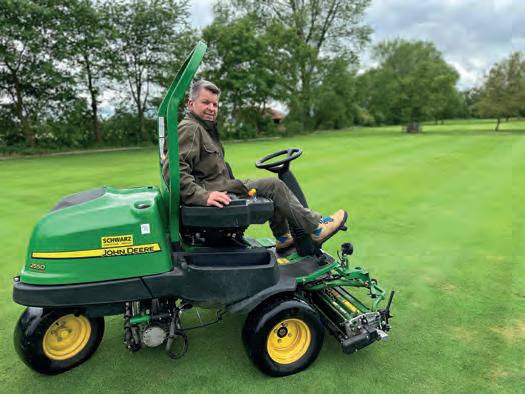

helping courses boost the accuracy of spray coverage as nozzles only cover pre-set.
In an interesting twist to the tech story, Deere notes that operator heart rate during spraying is far lower when they manage a machine fitted with a precision turf system than one without it.
Intelligent spraying is just one piece in the connectivity jigsaw however: managers running a fleet of turf machinery (Wentworth’s is 120 strong) want to know what their kit is up to and where, throughout the day.
Deere’s connectivity tech gives them that opportunity, as also promises Toro’s myTurf software, whether switching to an electric fleet or sidestepping costly repairs by maintaining and servicing machinery regularly.
Toro spent a decade developing the management tool for equipment and parts, operable whatever manufacturer’s machinery sites run. The web-based application tracks and manages ‘all assets’, using the office desktop or smartphone the course.
“In an industry like turfcare, a good fleet management system is more than just a want,” a Toro spokesperson states. “To free up more time to care for turf and wow players and spectators, it’s a need.”
Both myTurf standard, free version and Pro subscription options are available, the latter

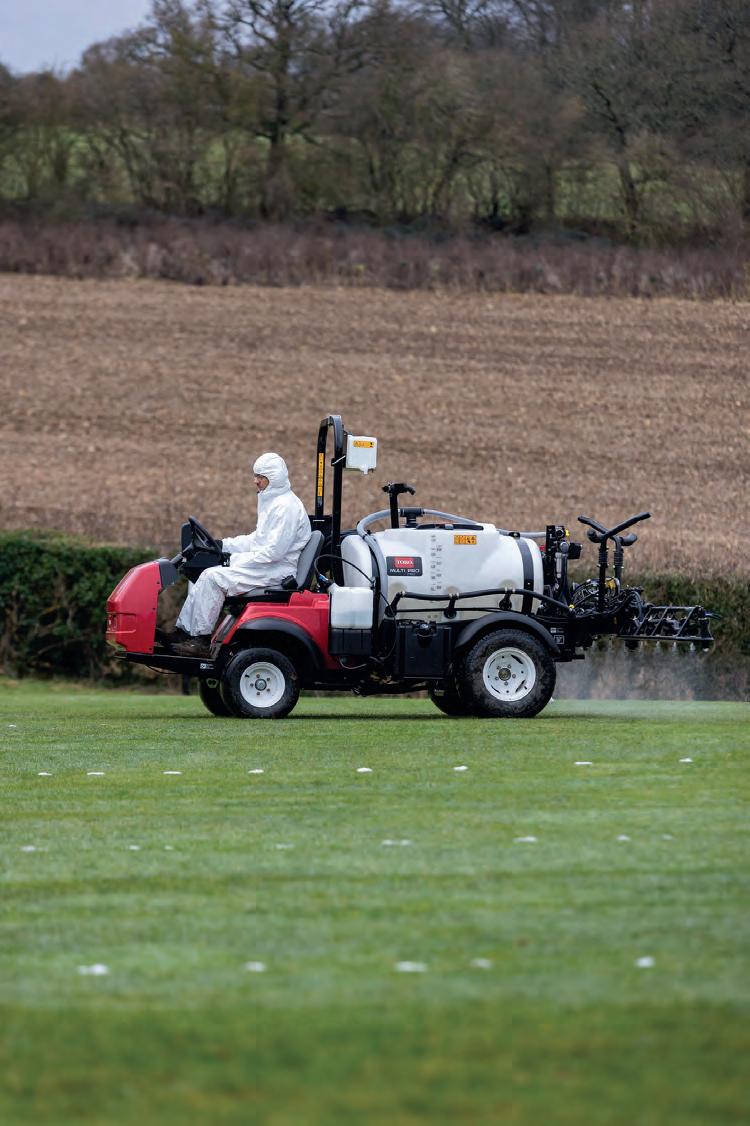

reordering machines and presenting a case to the board or committee, since you’ll have the figures to back your requests up. You’ll also be able to calculate the total cost of ownership for each linked machine,” Toro says.
The value of real-time data to help turfcare managers pinpoint potential efficiency gains is increasingly important – benefits making investment in connectivity a choice likely to deliver faster payback times.
Pro platform at football clubs and larger golf courses, where multiple fleets operate across multiple areas like a training ground and stadium,” the company reports.
‘Huge’ time savings are key gains for grounds teams and course managers in such settings, it adds, as there’s no need to physically travel to track equipment because the system delivers ‘full traceability and accountability’, vital when many staff are on duty.
Routine maintenance tasks, such as checking tyre pressures or wheel nut torque, lets managers stay ahead on preventive measures to help extend machinery lifetime and reduce unplanned downtime and unbudgeted costs.
Once the machine serial number is inputted or QR code scanned, software serves up a full maintenance schedule. Inventory management and automated reordering help avoid stock issues too, and teams can track a service or repair status in real time.
Strategic planning, using connected tech, lets managers schedule machinery tasks, see it in the field, create reports on equipment performance, maintenance history and fuel consumption to make evidencebased decisions.
“Data insights are important when discussing
Much of what’s available to the turf sector has transitioned from the agriculture, Deere says, with more still to come, and big brother fears don’t appear to have materialised.
Feedback suggests greens teams are welcoming the ‘connected course’ as a way to raise efficiency and boost productivity across the board, Deere reported at the presentation. And those who leave the team aren’t forgottenthey leave a recorded legacy of work managers can pass on to their successors, a valuable training aid potentially.
After all, why shouldn’t course managers, or grounds professionals across sport and leisure for that matter, have the tools and data to let them raise efficiency, prioritise decisions based on evidence and ease the work cycle of their team?
Information is power, and the control managers have over the maintenance function can hand them the means to argue persuasively in the clubhouse for more resources.
“It’s about doing more work in less time, comfortably,” said Christoph Metz, John Deere product marketing manager for turf, presenting. “The journey starts with connectivity and educating customers for what’s coming.”
Article by Greg Rhodes.









































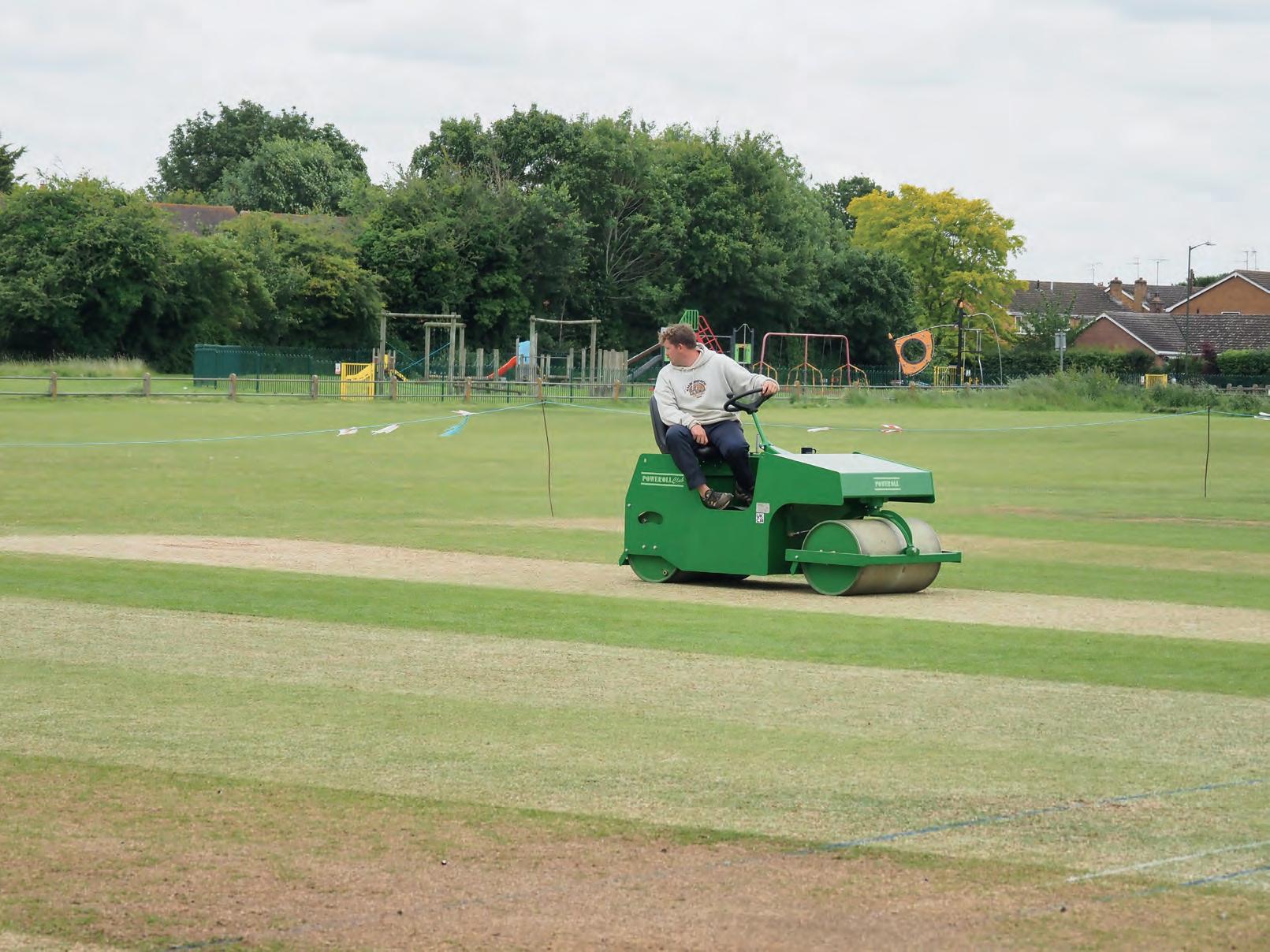
They say if you want a job doing well, call in a specialist, and that’s the approach behind Willow Turf Care, offering a cricket groundsmanship service to clubs in the Midlands.

Richie Woodmason cut his teeth in Australia, benefitting from training by Philip Petrievich. After roles as head curator at Willerton District and Western Suburbs cricket clubs, he returned to the UK, ending up as assistant head groundsman at Trent Bridge just before Covid.
“I was made redundant after Covid and eventually decided to become self-employed,” he explains. “There’s a growing number of clubs who are struggling to find part-time groundsmen or volunteers who have the skills or
time to help with grounds maintenance.”
Wellesbourne Cricket Club in Warwickshire is a good example. Situated in a bustling, expanding village near Stratford-Upon-Avon, the club is part of a community sports association, whose ground is also home to the bowls club and Wellesbourne Wanderers FC.
With history tracing back to the early 19th century, it’s one of the oldest clubs in Warwickshire and indeed may have been the original base of the county cricket club, now at Edgbaston.
On Saturdays, the 1st XI play in the Cotswold


Above
Below
Top Richie Woodmason (left) and Chris Calcott - an experienced partnership working together for cricket.
Bottom A strip under maintenance in June 2024 –verticutting, brushing and rolling.



A strip being prepared after five passes with the brush; poa makes it difficult to get the leaf to dry out. Three or four more passes with the brush, a final cut and sweep up and it’s ready to water and sheet.
Hills League Premier Division – the club was a founder member of the league. The 2nd XI are in Cotswold League Division Three; there’s also a senior friendly on a Sunday.
There’s a burgeoning junior section which includes the ECB All Stars and Dynamos programmes.
Chairman Phil Rothwell comments: “We have approximately 250 junior members, and most of our senior teams have come up through the junior ranks. We’ve also invested nearly £225,000 in recent years to improve the clubhouse facilities for cricketing and social use.”
Willow Turf Care took over at Wellesbourne at the end of 2022, after two volunteer groundsmen suffered ill health and one sadly passed away.
“Richie had previously approached us about doing our end of season renovations and I’d kept his details so could discuss the possibility of a contract package,” recalls Phil. “We need help
on a seasonal basis, and I felt we could get full value from his services.”
Central to the operation is Chris Calcott, who looks after a couple of Warwickshire clubs alongside Richie, and has worked at Cheltenham College and Adelaide Cricket Club.
“There are 13 strips in total – nine for seniors and four for juniors,” Chris explains. “The top seven have been down some fifty years, with the rest added on as the club has expanded.”
The pair describe the handover at the club as ‘seamless’ with a supportive committee headed up by Phil.
“There’s always plenty of help to put sheets on, and they do it precisely to Chris’s instructions,” says Richie. “The main challenge is that the club is so busy. In June, there were 26 fixtures in 30 days; 20 is normal and the teams also train on a Thursday.”
The ground, on the outskirts of the village, is on sandy soil – unusual for the mainly clay county and Chris describes it as being in

Above Some machinery is owned by the club, but Richie Woodmason is also investing in kit to make work such as renovations more efficient.
Below The square came out of a tough winter well – it is seen here in April 2024, ready for match preparation.
two halves, with lots of poa in the more open top end.
“It dries out quickly – after 6-7mm of rain in the morning, we can be rolling by evening.”
Willow Turf Care’s contract runs from April to September, so Phil and his team of volunteers care for the ground over winter, also taking on pre-season rolling and fertiliser application.
“Juniors play on the bottom four strips and the coaches are happy to use the markings and accommodate us in looking after them,” comments Chris. “This section holds more water, and we treat it slightly differently because of the wear it receives, leaving more grass on to get it through the season.”
The spirit of co-operation is even more

with a team of three or four groundsmen.
“I’m always aiming to offer a premium service, regardless of the level of club, and committees seem very happy with this. I’ve looked at a range of fertilisers, for example, but the premium products offer the best value and results.”
Thus he kicks of the season with ICL Renovator and Coldstart to give the pitch a boost in April.
“We’ll use a liquid iron feed to harden up in a wet spring and then feed once a month.”
Investment in machinery has come from both client and contractor with Wellesbourne CC adding a new Powerroll for this season.
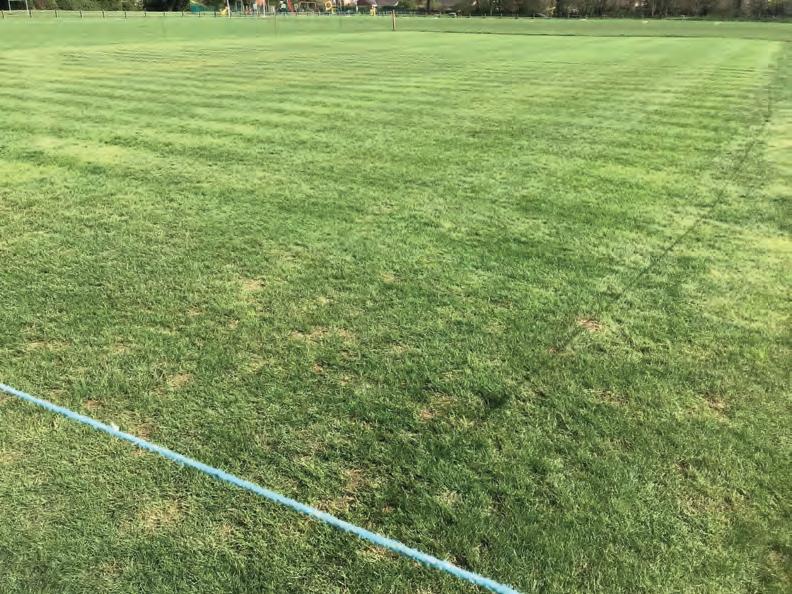
“You can’t beat Powerroll for customer service and it was a competitive price,” comments Richie. “It’s easy to maintain with a proven Honda engine, and straightforward enough for the volunteers to use effectively – up to 15 different people can be on the seat through the season.”
Brushing is key for the older strips, Chris comments. “We can brush with the Sisis 30-40 times over a two-week period and early season rolling is vital as they dry out so quickly.”
A pair of Allett mowers are deployed, aiming for a 7mm cut height by the Friday before a fixture.
“We’ll get down to 15mm in the last couple of weeks before the season - or may back off to 17-18mm if it turns wet - and can be cutting twice a week as it grows so quickly. Verticutting is important to tackle poa, especially when starting a new strip, and it’s essential to take out lateral growth pre-season.”
At a time when environmental issues are coming under the spotlight, Richie is keeping an open mind on options such as electric mowers.
“You can still see downsides such as the environmental impact of battery disposal, but it

has to be under consideration if that is what the client wants.”
Chris adds that while watering will always be a key part of cricket pitch preparation, the club committee are fully conversant with the need to put sheets down to help conserve water.
Communication is essential, points out Richie; Willow Turf Care’s contract is MondayFriday with the club making final preparations such as removing covers.



“We have a What’s app group which includes the senior captains and coaches. Each week, we’ll post a pitch report and that includes clear guidance on what needs to be done by the volunteers. It avoids mistakes and ensures that everyone is kept informed, which is especially important when there is a Saturday and two Sunday matches. We have a great relationship with Phil and his committee.”
Come the end of the season, renovations aim




Left There are 13 strips in total which get plenty of use –the month of June seeing 26 matches.













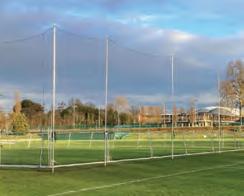







Above The First XI play in the Cotswold Hills League Premier Division.
Below
The attractive pavilion, which has seen considerable investment to improve it for cricket and social use in recent years.
Below
The ground, which backs onto the community centre and gym, also offers nets for training, an important resource for the 250 junior members.
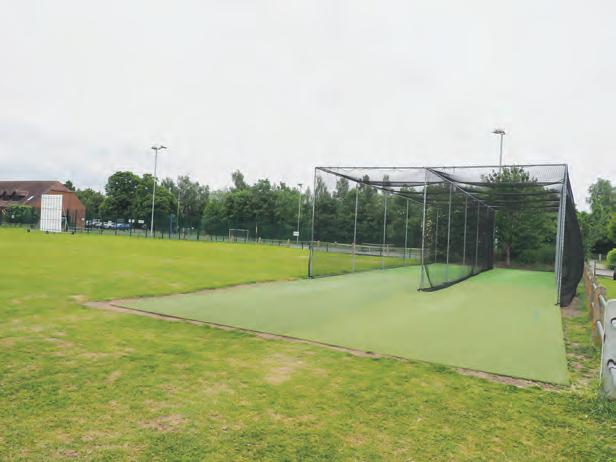
to get the pitch ready for the next year.
“I use a Sisis TM1000 scarifier and how that machine copes and what comes out tells me a lot about the state of the strips,” explains Richie.
“It came out heavy and thatchy last year, but we got really good results with lots of grass cover over winter with the sward going into spring thick and dense. That wasn’t the case everywhere last winter and it stood us in good stead for this season.”
The TM1000 got down to 6-8mm, using 3mm blades at 19mm spacing, which took out more than 90% of the poa, before overseeding with MM50, fertilising with Evolution and topdressing with K-loam.
“You’ve got to get the timing right for seeding – if there’s no rain for a couple of weeks, it can take a long time to germinate. If you get a downpour in the second or third week of September, when you can get back on again,

coverage is much better.”
The pair are already planning ahead for autumn at Wellesbourne – Chris would like to have it Koroed and apply glyphosate to get rid of the poa, plus there are some ends that he’d like to get flatter.
“We’re progressing all the time – we’ll have two tractors and scarifiers for the autumn, plus I’ve got a Toro Workman coming which could have a topdresser fitted, and which will make it all a lot quicker,” says Richie.
He comments that this spring has seen a wide variety of conditions at different grounds, depending on their location – with cold soils and poorer grass growth at some of the more southern clubs. “Every year is different and brings a new set of problems. It’s great to have Chris to bounce ideas off and between us we have a lot of experience.”
Pitch standards are clearly very important to them both.
“We want to provide the best possible surface for every game. The youth coaches are always very complimentary and youth fixtures are an excellent shop window for our services as the coaches from other clubs tend to travel with their teams.”
It’s clearly working for Wellesbourne, as Phil says: “There’s tremendous demand for cricket which we’d like to meet with more junior games, but to do that you need to have the right maintenance in place. It’s made a possibility by having professional groundsmen who can prepare the strips in the week rather than a volunteer groundsman rushing to do them on the evening before. In the future, we may dedicate more tracks to junior cricket as so many games are played on them, and we’ve got the resources now in place to do that.”
Article by Jane Carley.
HIGHSEEDPURITY
NEW 2024 FORMULATION BLENDSFOURTOP-RATEDPERENNIAL RYEGRASSCULTIVARS
OUTSTANDINGQUALITYACROSSALLCRICKETPLAYINGAREAS
EXCEPTIONALDISEASERESISTANCE, YEAR-ROUNDCOLOURAND RECOVERY
PRONITROCOATEDOPTION AVAILABLE GROMAX COATEDFORIMPROVEDESTABLISHMENT



J Premier Wicket delivers proven results at the highest level – rapid establishment, high disease resistance and camera appeal can be expected as standard.

A recent irrigation upgrade, as well as several sustainability projects, have been key to course development at Bamburgh Castle Golf Club.
Head greenkeeper Gareth Pearson and his deputy Mark Linsley talk us through the benefits.
Before the irrigation improvements, some of the team would hand water greens for at least an hour every day. “Hand watering wasn’t making a positive impact,” commented Gareth, “and areas of the course were being neglected because we didn’t have the manpower to manage them. The old irrigation system worsened every year but finally, last year, we installed the Toro irrigation system for the greens and tees.”
The system has cost the club nearly half a million pounds, but Gareth is confident it will be worth it for the long-term success of the course: “It isn’t the easiest terrain, so the installation was difficult, but we are already seeing the benefits of utilising it as a management tool; when applying wetting agents before the new system, we wouldn’t have been able to if it was
too windy or there was no rain. Now, we can pick a week to topdress and apply wetting agent whilst using the system to its full potential.”
Deputy Head Greenkeeper Mark Linsley expanded on the benefits: “We were able to utilise the new system a lot at the end of last summer and we saved the man hours for other jobs.”
The benefit of managing coastal courses
Having worked on a coastal course his entire career, Gareth feels that if you have the correct grasses and keep on top of your work ‘coastal courses can manage themselves’. Mark backed this up: “In my previous course, we had a few issues with fusarium and had to take action. However, here at Bamburgh, we have gone thirty years without using a fungicide. I don’t know if it is the coastal breeze keeping the dew off, or

the course management, but it’s great from a sustainable point of view.”
Gareth highlighted the challenge of having half the course on farmland and half on the coast: “On the farmland side, we have to sand that much more than the coastal side in order to try and firm it up throughout winter. The farmland greens also need more verti-cutting and brushing, and there is more rough grass compared to the fescue we have on the coastal side.”
Mark added: “The farmland greens also hold more water compared to the coastal ones, despite them being closer to the sea, therefore, they sometimes need more maintenance.”
Like many, the weather has affected a number of projects that Gareth and his team have been able to complete this winter. He explained: “Usually, we would have maintenance finished by Christmas, then it would be drier and we could start topdressing. That hasn’t been able to happen this winter.”
Mark added: “We would have two extra bunkers on the course had the weather not stopped us. They were due to go on the farmland side, but undertaking that during such extreme weather would have made a mess. It also wouldn’t be anywhere near finished.”
Pushing for sustainability success
Mark started at the club nearly three years ago and he has made it his mission to push the sustainability drive. “When I came here, I instantly saw the beauty of the course. The roughs are now full of native wildflowers, and we also have several red-listed birds nest here.”
All birds are protected in some form and Mark has a Schedule 1 bird licence which allows him

to check on the more protected species: “The licence is good because I can check the owl boxes to see if there has been any disturbance. We have recently installed a further five bird boxes which will hopefully attract more wildlife.”
Mark also explained why the rough areas are set free at Bamburgh: “They get cut twice a year and are raked out once a year. We have made it thin and wispy to cater for the wildlife more than the golfers.” Gareth also mentioned the benefits of the thin roughs: “Golfers were having slower rounds as they were constantly looking for balls but, more importantly, Mark has really made a difference from a sustainability point of view. It’s just about changing your mindset to think more sustainably and how to recycle. For instance, we recently completed a log clear out and, instead of those going to waste, we used the big logs to build bug hotels which appear to be successful.”

The club have entered the Operation Pollinator awards for the last two years and Mark is hoping to see success in the future: “Last year we didn’t make it through, but the year before we made it to the finals. It would be nice to go one step further and think we could have success this year.” Good luck guys!
Article by James Kimmings.

Changing the narrative: how we can turn the tide on the UK’s greenkeeping and grounds management
The greenkeeping and grounds industry is facing a recruitment crisis. Indeed, the last survey done on the subject by BIGGA found a third of greenkeepers were looking for a job outside of the industry and, when trying to replace lost staff, 80 percent of managers found recruitment a struggle.

However, as with any crisis, its extent will be inversely proportional to the action taken to overcome it. As such, it’s important our industry now turns its attention to recovery efforts – for both crisis mitigation and prevention – to ensure the stability, health, and longevity of the UK greenkeeping and grounds industry for many years to come. Here, Reesink Turfcare, distributor in the UK for turfcare equipment and irrigation products, considers the subject.
What do we mean by a recruitment crisis?
A recruitment crisis occurs when businesses or public organisations struggle to attract and hire qualified candidates for job openings. If unchecked, this can lead to understaffing, and therefore overworking of an already limited workforce, taxing their physical and mental wellbeing; lower productivity, because only so much can be done in a day’s work with fewer staff; and, counterintuitively, increased overheads, since more funds have to be spent on recruitment efforts.

What’s caused the recruitment crisis in the greenkeeping and grounds industry?
The recruitment crisis in the greenkeeping and grounds industry has been caused by numerous factors: demographic shifts, or an ‘ageing’ workforce; skills shortages, lack of training, pay and wider socioeconomic change in the UK, to name but a few.
A main focal point, however, should be netnegative; that is, there are more skilled and qualified people leaving the industry than there are joining it. By first addressing why people are leaving, and perhaps more importantly in this instance, why so few are joining, we will then be better able to strategise and take action to redress the balance.
According to a 2022 survey by the Grounds Management Association (GMA), about 3,220 professional grounds managers
Right
Reesink Turfcare is a proud sponsor of ‘Get Into Grounds’ strategy – led by the GMA’s NextGen – which seeks to encourage school leavers and young people to consider a career in grounds management.
will retire over the next three years. It’s now 2024, which means there’s a hole in our industry that needs filling.
But it’s not just a case of putting job adverts online and waiting for the applications to start flying in – a privilege many other industries might have. Whether we’re talking about golf clubs, sports venues or public organisations, there’s still the perpetuation of negative ideas about careers in greenkeeping and grounds work - that it’s a low-status and low-paying sector with limited career prospects; in other words, that’s it’s a sector on the decline.
As proud members of the greenkeeping and grounds industry, we know for a fact that’s not the case. But, unless we work to prove this wrong, misconceptions such as these will persist.
That’s why, as part of this community, we’re proud to be long-term sponsors of the Agricultural Engineers Association Conference and the annual BALI National Landscape Awards, both of which showcase the incredible work our highly-skilled sector continues to put out year-on-year, and the excellent, high-status employment opportunities it can offer.
Greenkeeping and grounds work requires a special skill set: horticultural knowledge, the ability to work with various turf and grounds machinery, and best practices in environmental stewardship, to name a few; while training programmes and apprenticeships do exist (in fact, they’re something we offer at Reesink), it’s clear young people outside of the industry aren’t necessarily hearing about them.
As the GMA survey points out, only 4 percent of those joining our industry did so because of guidance from their school or careers service. And, if we’re going to replace those retiring, then this needs to change.

Failing to do so will mean greenkeeping and groundsmanship remains behind a barrier, exacerbating the skills gap.
As an industry, then, our main priority should be to address the shortage head on – to put together a coordinated effort to attract young and fresh talent, while also promoting training programmes and educational pathways. Because the clock’s ticking.
We can change the narrative by employing strategic solutions to ensure better recruitment. And that begins by promoting the profession more broadly, but with a specific focus on – and, indeed, by paying a closer attention to – those underrepresented in our industry: young people, people of colour and women.
Figures from BIGGA show our industry comprises 96 percent men, of which 97 percent are white and 36 percent are over 55; while just 3 percent are represented by those aged between 16 and 24. Yet, as many of us will attest, one of the best things about our profession is the diversity of the work. And diverse work requires diverse skill sets.
By highlighting this need for diversity, as well as the myriad opportunities for professional development in our sector, we can

It’s not just a job, but a career, and an enjoyable, rewarding one at that
engage with the underrepresented demographics of our community, encouraging them into greenkeeping and grounds management, which will then ease the burden of recruitment struggles.
We’ve had the immense pleasure of working closely with BIGGA on the Toro Student Greenkeeper of the Year Awards – an idea we hatched with Toro back in 1989, says Jon Cole, divisional business manager - turfcare, at Reesink. The awards allow




course managers and lecturers in the UK to acknowledge their top employees and students by nominating them. Those who win receive lifechanging educational prizes, along with rewards for both the runners-up and the nominators.
While it’s great to win, the awards are more a celebration of greenkeeping and the strong cross-association links that act as a supportive backbone to the industry. Therefore, we’d encourage course and club managers to consider nominating their young greenkeeper of the year – because it’s not just a remarkable event to be part of, it’s a vote of confidence in the future of your organisation and the future of our wider industry.
David Timms, national accounts manager at Reesink, explains how Reesink is also thrilled to sponsor the GMA’s NextGen, a brilliant group of likeminded young people, all of whom are under
the age of 28 and are enthusiastic about a career in grounds work. By dedicating their time to initiatives like ‘Schools Into Stadia’, which strive to encourage 14-16 year olds to consider careers in groundsmanship, and volunteering at local sports clubs, the NextGen represents yet another vote of confidence in the future of our sector.
David comments: “Reesink is passionate about supporting the progression, development, and future of the grounds industry. To have this kind of access to the next generation helps us engage young people in the possibilities the sector offers. We must congratulate the NextGen for organising a fantastic and worthwhile event we were proud to be a part of.”
In short, then, perhaps the single greatest strategy for solving our recruitment crisis isn’t so much ‘optimising your recruitment channels’, as many online guides would have you believe, but rather it’s really as simple as inspiring confidence in our industry – because confidence is contagious, and in doing so, we can work to transform the negative, erroneous assumptions made about careers in greenkeeping and groundsmanship.
Get involved with awards like Bali National Landscape Awards and the Toro Student Greenkeeper of the Year Awards, and show your support for new people entering the profession – regardless of their race, gender or age.
Let’s make a buzz about our industry and the diverse work and myriad opportunities it can offer – that it’s not just a job, but a career, and an enjoyable, rewarding one at that. Let’s get involved and work together to promote greenkeeping and groundsmanship so schools and careers services want to sing its praises. Only by inspiring that confidence can we redress the balance and futureproof what is undoubtedly a fantastic industry to work in.

For further information, please contact Reesink Turfcare on 01480 226800 or visit reesinkturfcare.co.uk




















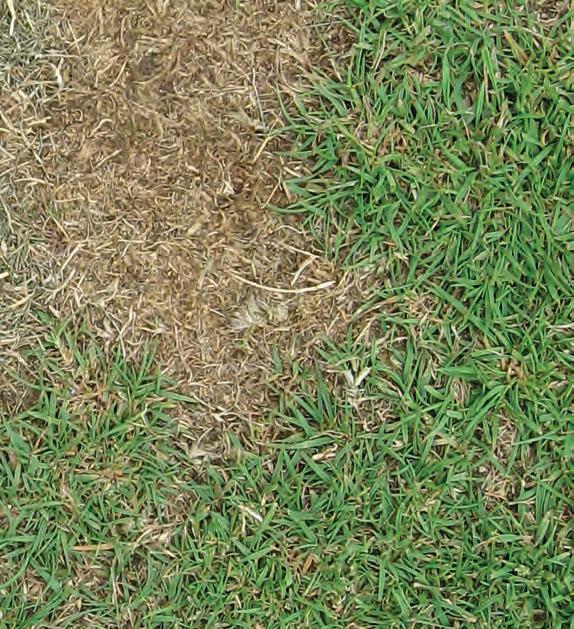




























































































ANTHRACNOSE IS HUGELY INFLUENCED BY TURF STRESS. HOT AND DRY WE ATHER CONDITIONS TRIGGER FOLIAR OUTBRE AKS, OR COOL AND WE T CAUSING BASAL ATTACKS. ASSESS SPECIFIC WE ATHER DATA RISKS - ALONG WITH NUTRITION; GR ASS SP ECIE S; IRRIGATION AND SOIL TY PE - TO MANAGE YOUR ACTIONS.
Create your personalised Turf Advisor anthracnose dashboard to suppor t all your Integrated Turf Management strategies.
AIR TEMPER AT URE
Hot dr y conditions will create a stressed plant more susceptible to at tack from anthracnose. Reference recent days and coming forecasts to assess risks and actions.
LE AF WETNES S & HUMIDITY
Another two weather da ta sets to work in tandem. Humidity is a great guide to mo st foliar disease risks, while leaf wetness is less reliable but a good indicato r.
COOL SE ASON GROW TH POTENTIAL
Turf that is actively gr owing will enable be tter recovery Anthracnose is triggered by high temperatures, so the onset of disease will usually occur whilst GP gures are high.
• Fr ee to download and use
• Available for all gr eenkeepers, turf managers and agr onomists
• Fully customisable for location and situatio n



• Adaptable through the season for current challenges
• Suppor t to make bett er day to day decisions and planning
GREENCA ST A NTHRACNOSE MODEL
Compiles a range of weather metrics to assess risks of conditions favour able to disease. Set your own risk aler t limits in the Turf Advisor dashboard - zero is low; 4 is high.
RA INFA LL & EVAP OTRA NSPIRATION
Dr y soils are a driver for plant stress, making the plant more vulnerable to at tack . But also be aware of lower cutting heights in wet conditions as a further trigger
SPRAY WINDOW
Identif y your opportunities for conditions to take preven tative action at the risk assessments for the optimum timing


